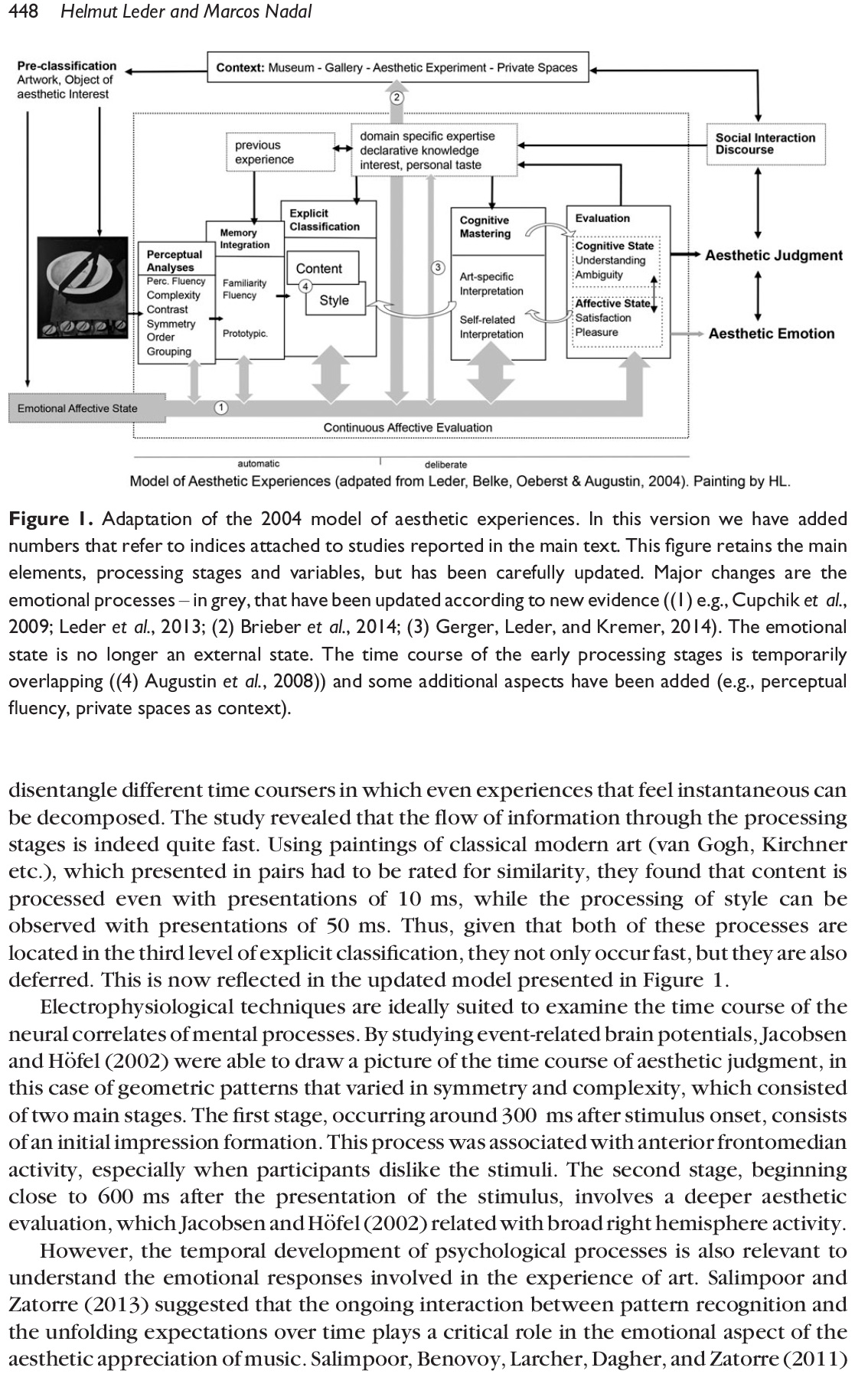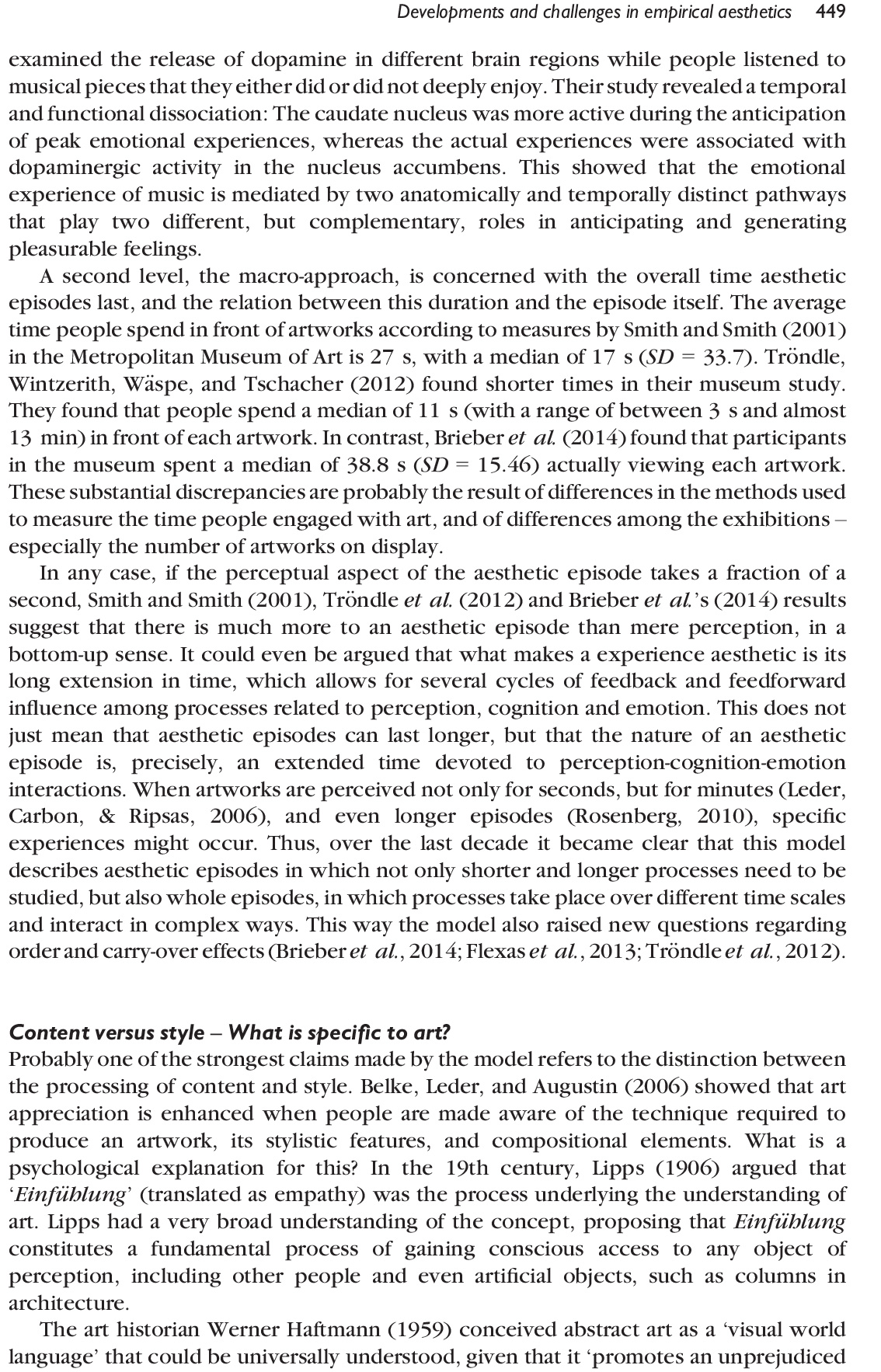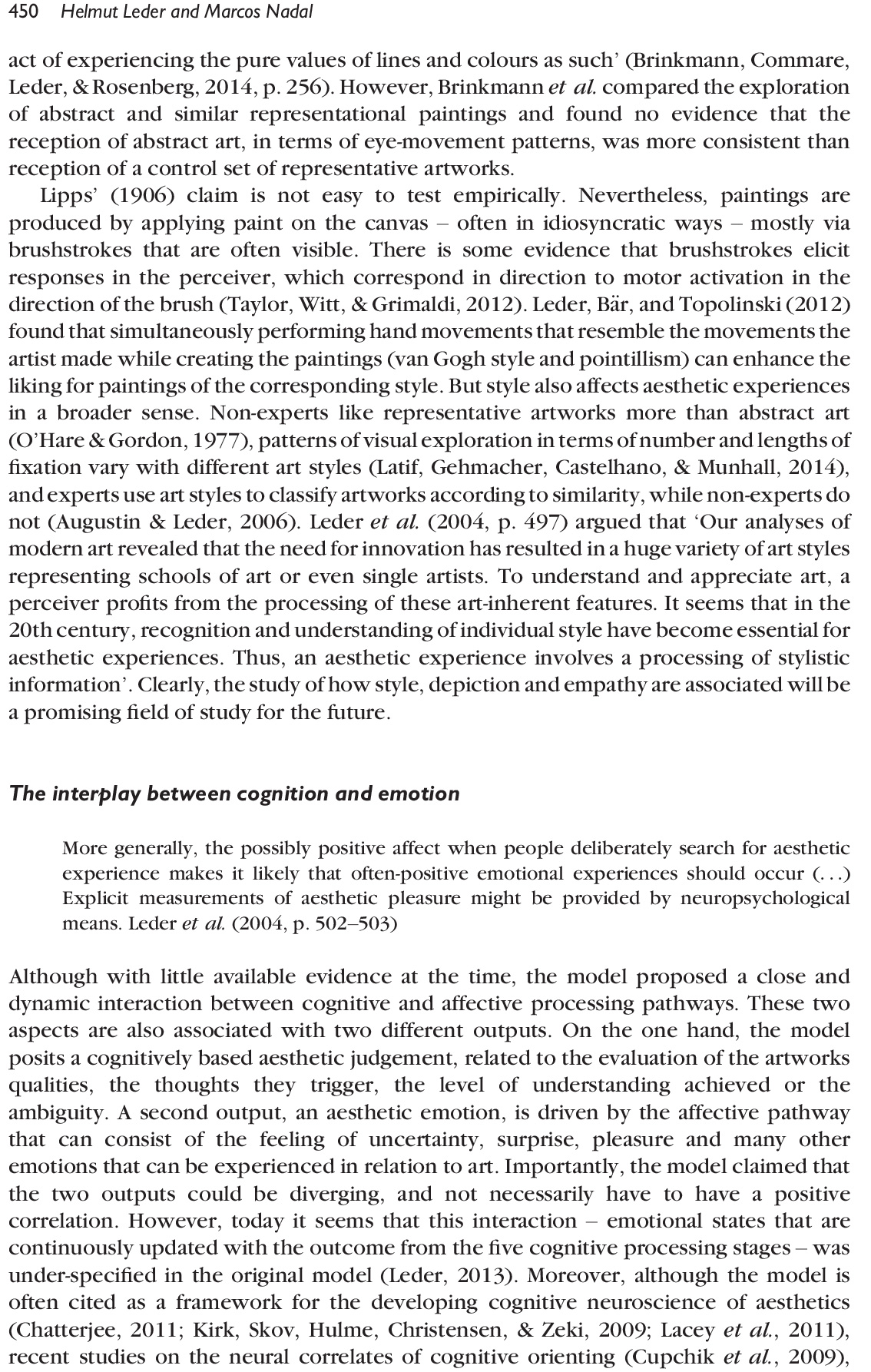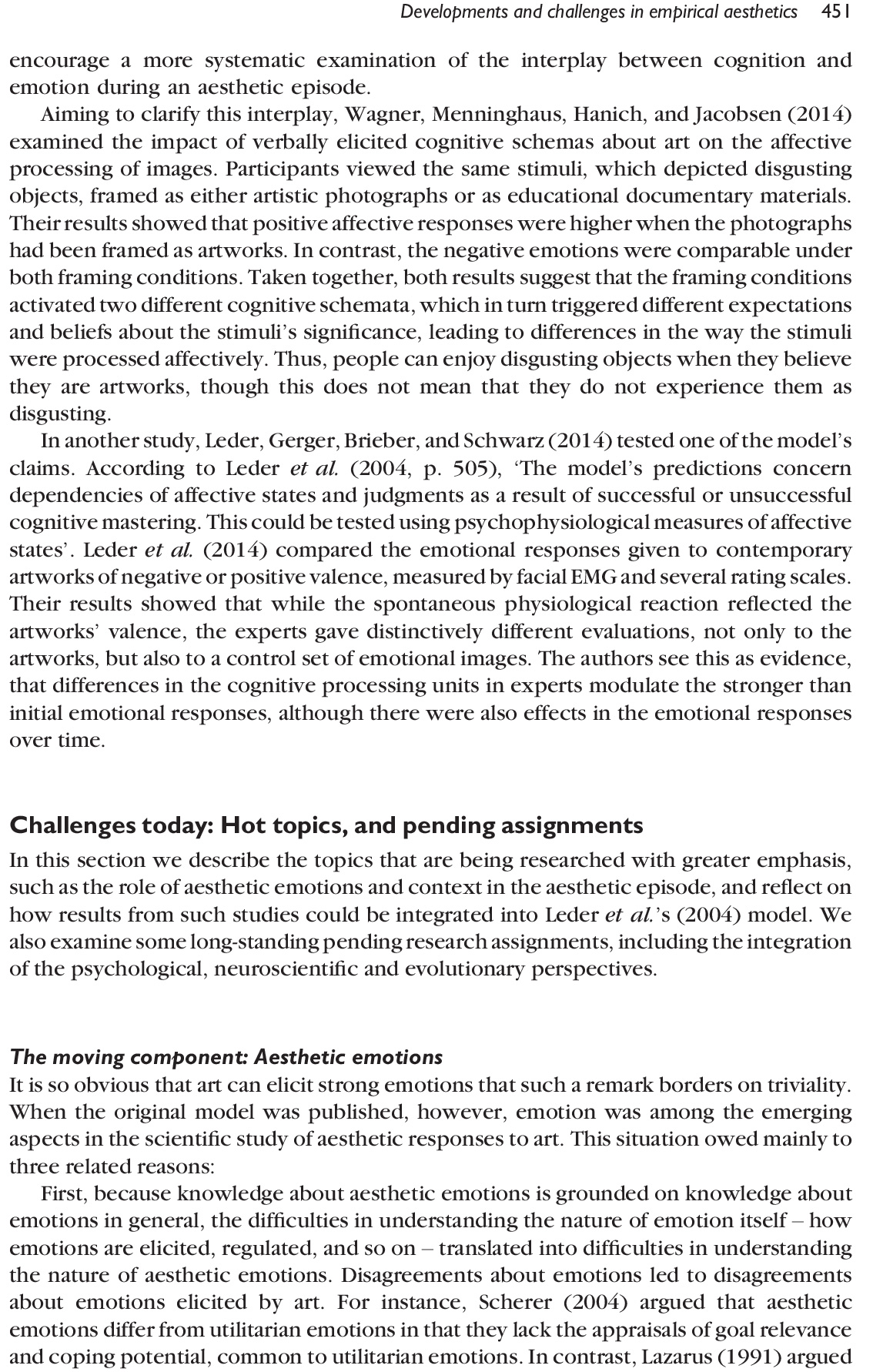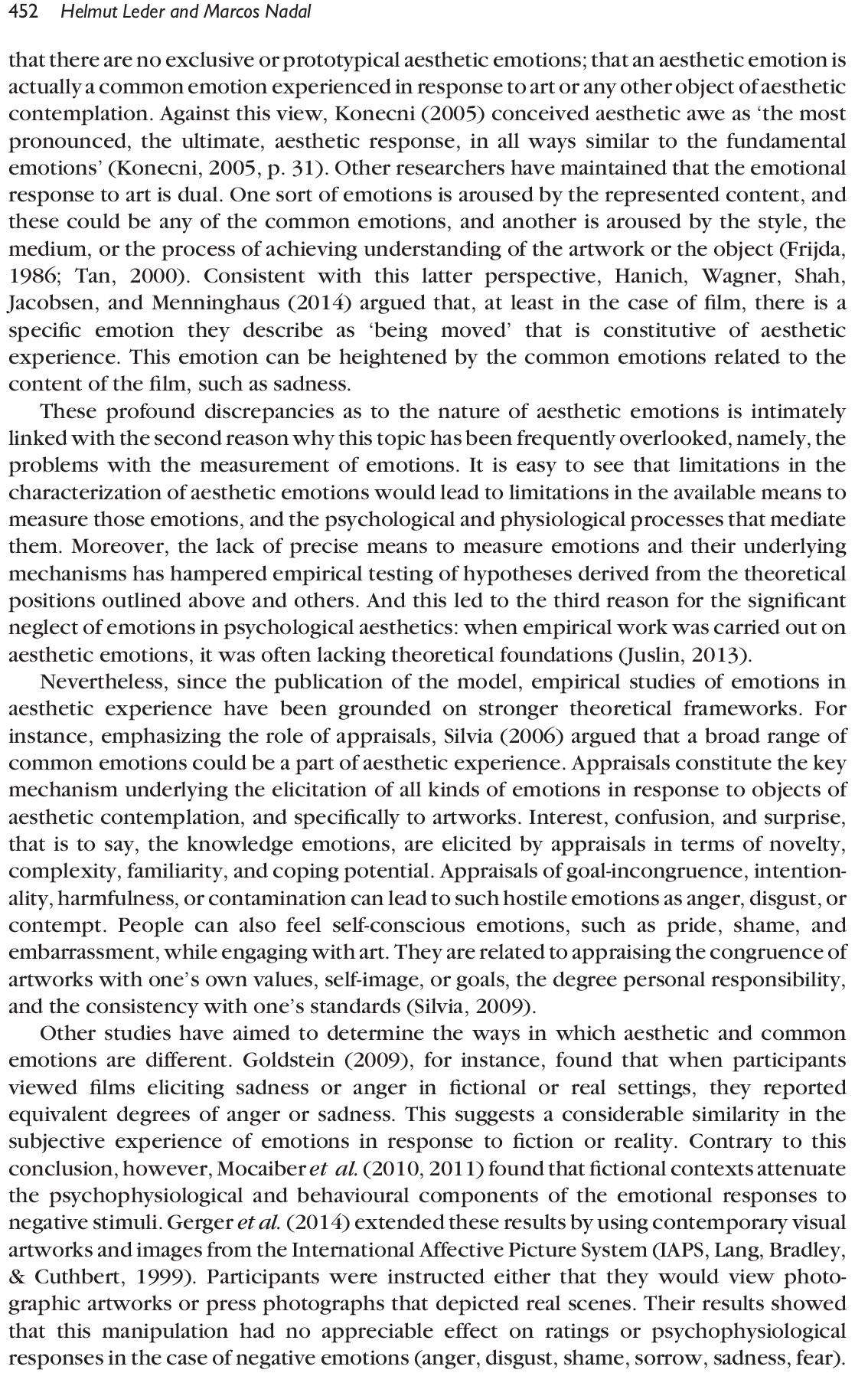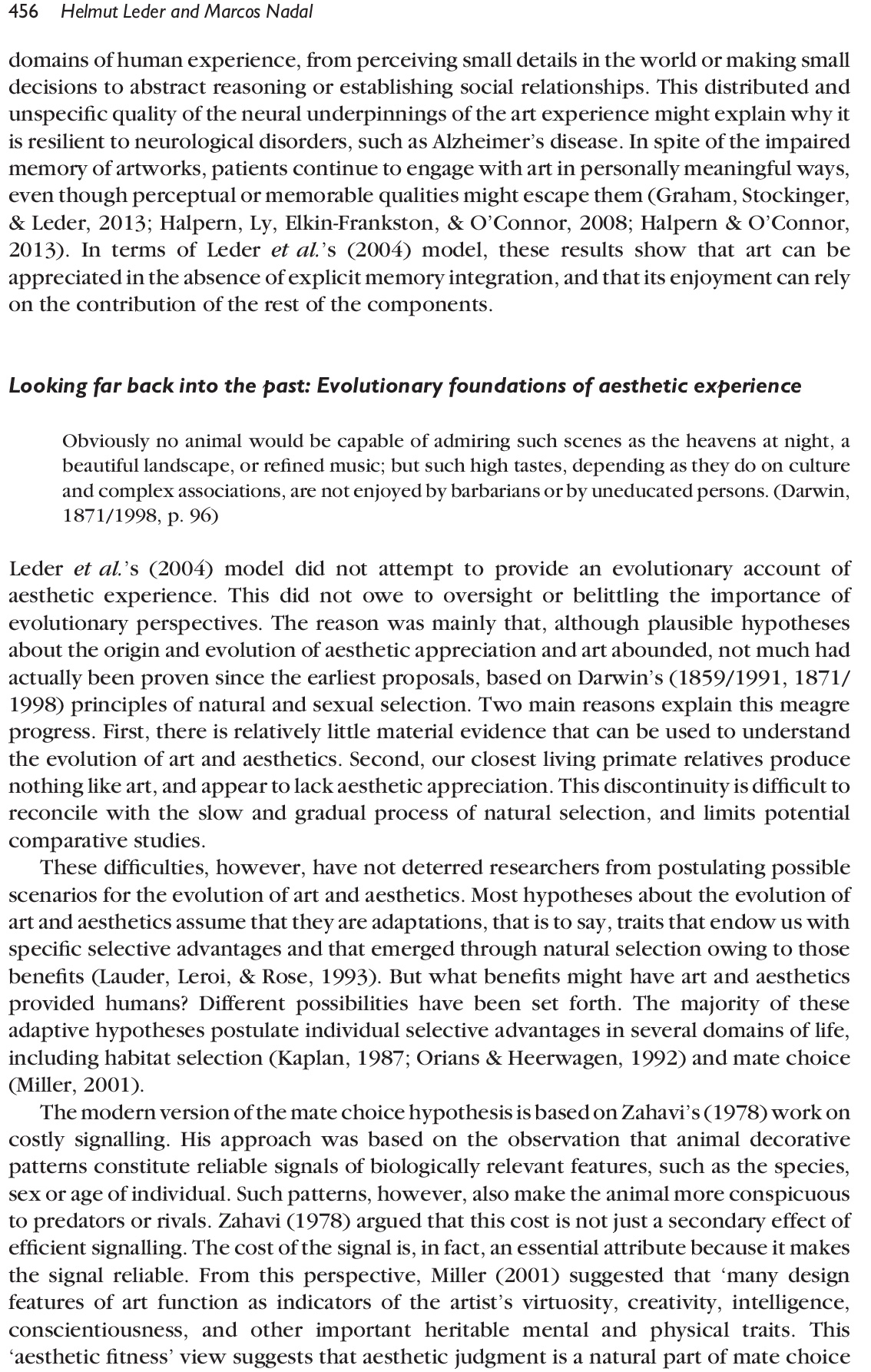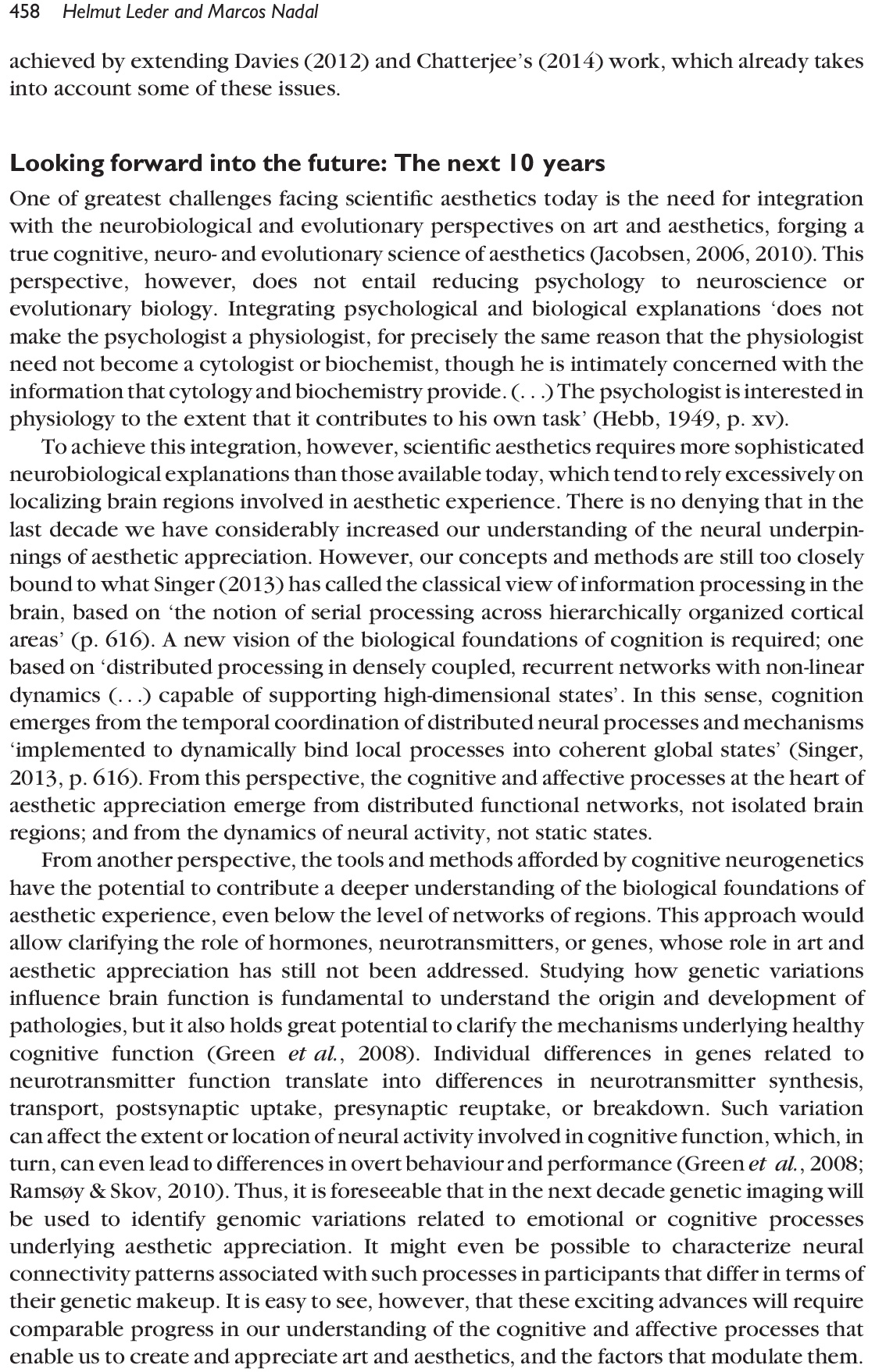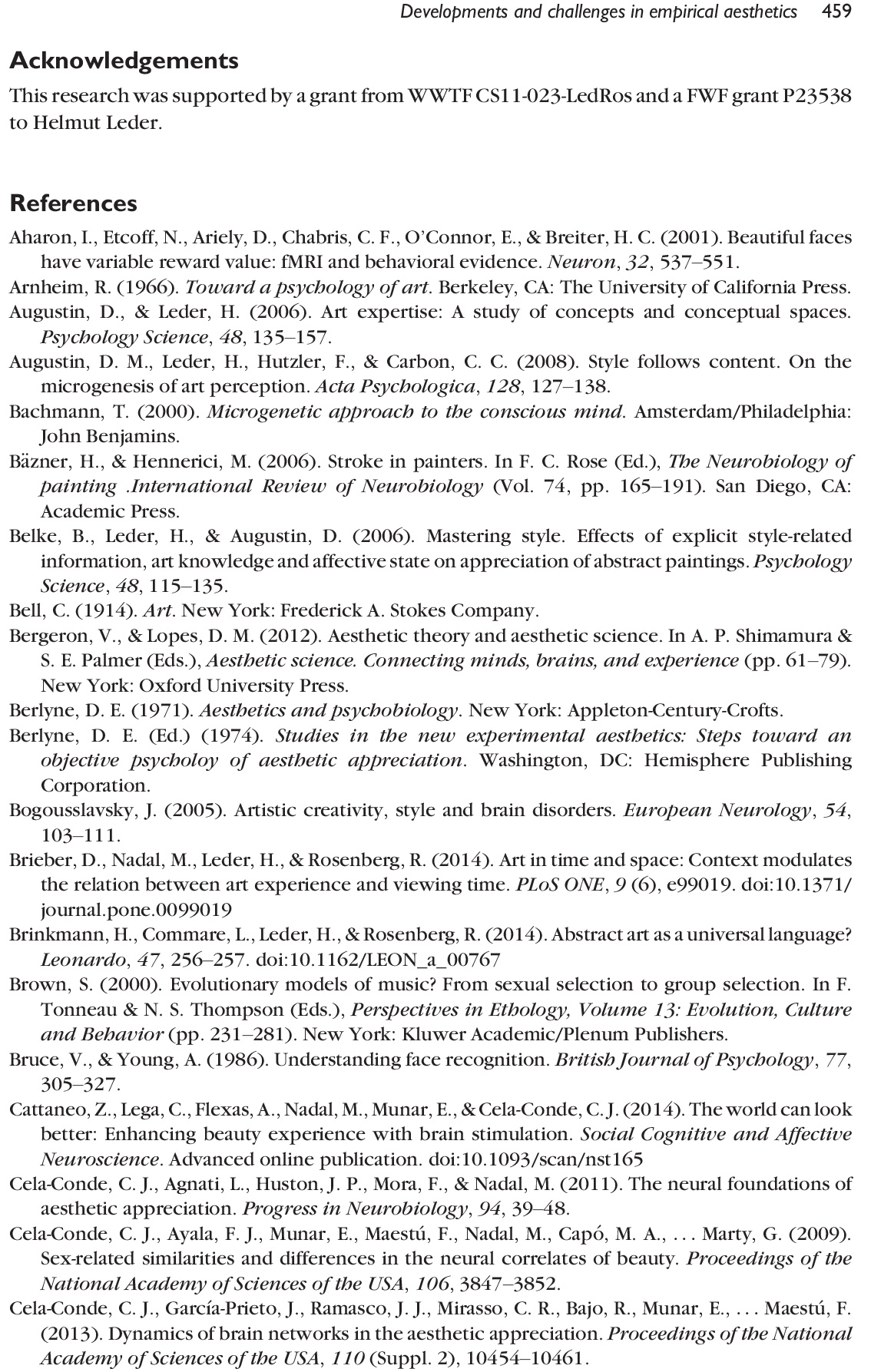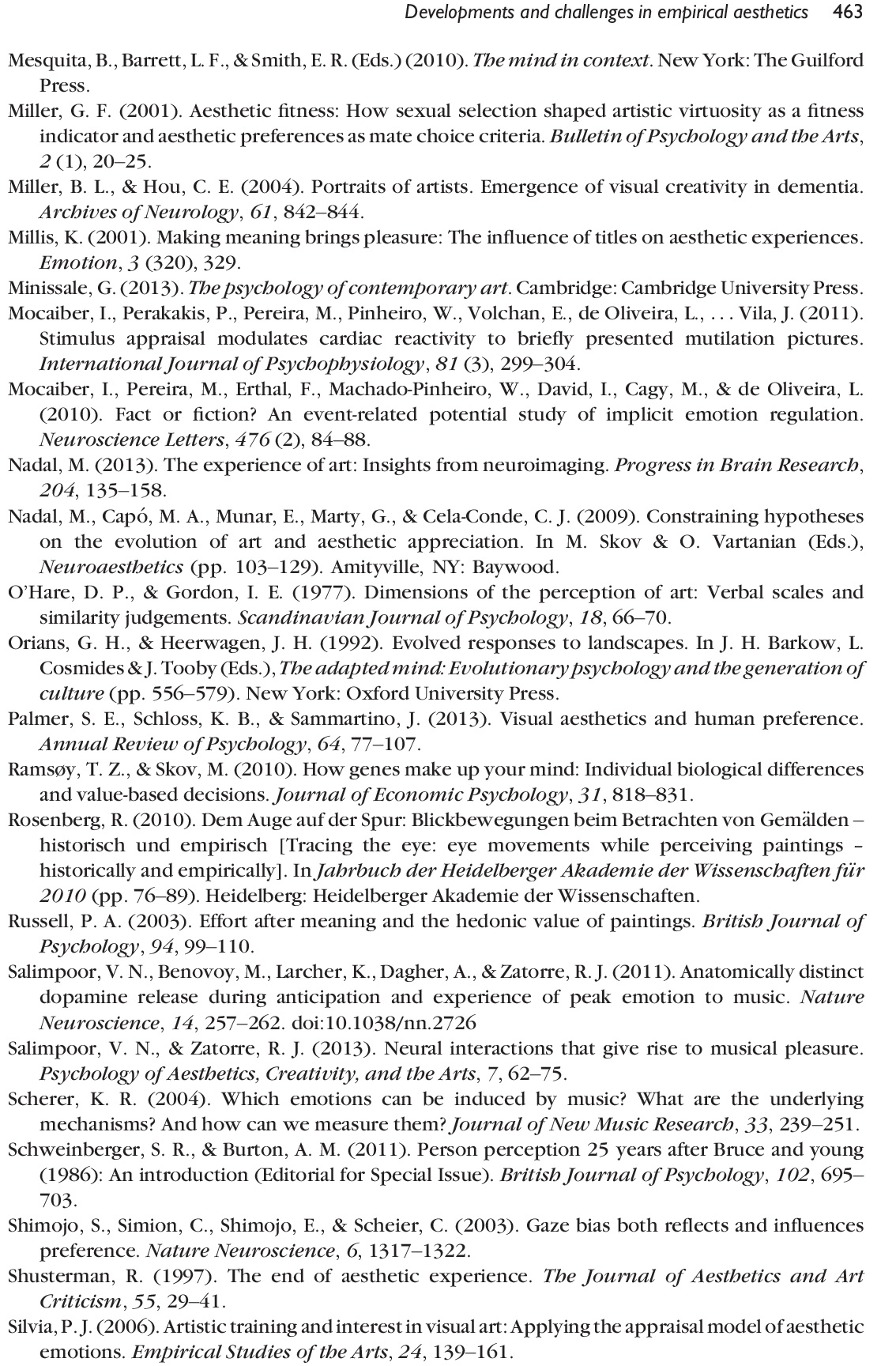Reflections
The work of art is not ‘Surrealist’
Guillaume Bottazzi – may 2025
The Surrealism of neurobiologist Jean-Pol Tassin
Jean-Pol Tassin, neurobiologist, director of research at Inserm and addictologist, has written L’inconscient aux commandes. In one of his lectures, he explains that “there are two modes in our brain, an analogue mode and a cognitive mode. The cognitive mode is slow, and acts on neuromodulators or neurotransmitters that are dependent on affectivity“.
I note in his representation of the individual that there are no purely objective thoughts in man, since the cognitive mode depends on our affectivity.
“These may be behavioural regulation systems, or those that produce serotonin and dopamine, for example. Our dreams only last a few seconds and it’s a phase that processes our information analogically, even if we find it hard to believe. Our analogue system is a regression. A lot of people talk about dreams and say all kinds of things. Analogue processing is the absorption in a few milliseconds of elements that have an impact on our brain and that will serve as a reference to impact us later. Children, for example, function in an analogue mode, they don’t have a cognitive mode. This means that they can walk without knowing how. We have neurotransmitters such as neuro adrenalin, which wakes us up, serotonin, which protects us, and dopamine, which ultimately decides the hierarchy of structures so that behavioural behaviour is adapted to our behaviour. So dopamine is not just for the reward circuit. Its modulators are extremely small – 500,000 out of 3 billion – and yet these neurotransmitters are responsible for our modulation and regulation, and therefore have an extremely important psychological effect. Depression, for example, is a depletion of the neurons that regulate dopamine and serotonin. Antidepressants allow these neurons to rest and return to a normal state. When we fall asleep, the regulators gradually shut down during REM sleep, so that cognitive processing is no longer possible because the modulators have stopped. And it’s important that they are stopped because they are extremely fragile and need to recover and rest. The brain works all night in analogy, but as they are fragile they cannot stop for more than twenty to thirty minutes. So we wake up an average of a dozen times a night. When the modulators restart, they trigger cognitive functioning and what happens is that you are in a state of analogy, so you have no perception of what is happening and physiologically, there is a modulator reactivation and between the time you wake up and go back to sleep, you may or may not have a dream. This dream will last from 500 milliseconds to one second to three seconds. This dream does not take place during sleep but during micro-awakenings. Sigmund Freud said that dreams are uncensored, but that’s because it doesn’t have time for censorship. Dream interpretation is linked to the detection of dream symbols. For him, the artist translates his analogical dreams into cognitive terms, and the artist who touches you, touches you analogically, it’s not cognitive. The emotion you get from a work of art comes from the unconscious, from within. The dream comes from real sensations and emotions.”
I note that for him the analogue mode is a mode linked to sensations and emotions.
“Since 1960, the neurophysiologist Michel Jouvet had identified REM sleep, a part of sleep in which we sleep but our eyes move and as they move he considered that we dream during this period and since many people believe it. In reality, you can’t dream during REM sleep because the neuroregulators are inactive. You can have a dream during the micro-awakening that follows”.
To sum up, from the point of view of neurobiologist Jean-Pol Tassin, the analogy is our unconscious. It reveals our affect and our links to a specific experienced environment. It shows the being without filters and without limits and this implies that for him the work of art is a surrealist act that reveals our deepest truth named the unconscious.
The work of art is not surrealist
I had a dream last night that I remember; it intertwined my experiences and my feelings, it exacerbated my fears, and it was mixed with real situations as described by Jean-Pol Tassin.
I’ve never dreamt abstractly, and I don’t paint figurative works. There is no sleepiness, no dreaminess, no aesthetic lightness in my dreams, and precisely not the kind I find in my creations. There is no link with an approach to form, an atmospheric quality to the images or an aesthetic interpretation. There are no dreams that go in the direction of my imagination, and I feel more inspired by observing a landscape when my dreams don’t inspire me.
Gaston Bachelard‘s imaginary world is prior to thought and feeling; it is an imaginary world that is reconstructed and not something that is suffered. This imagination allows us to appropriate spaces, to find ourselves in tune with our history, to recreate ourselves, confronted with the unreality of images, to rebuild and renew ourselves. This imaginary world takes shape while we are awake. It is the fruit of conscious and unconscious reconstruction.
In my opinion, the imaginary is beautiful and comes from an awakened creative act. It is an act of sublimation as described by Sigmund Freud. It’s the transformation of energies that come from outside and inside, it’s the reconstruction of an integrated being that’s trying to surpass itself.
‘Everyone has thought that sleep is of the brain, by the brain and for the brain. We neglect the fact that we are not brains, we are mechanisms, we are integrated, everything we do is integrated with everything else’ explains neuroscientist Paul Shaw from Washington University in St Louis.
Imagination is a mental thing, the fruit of reconstruction, a reinvented universe that helps us to live better and to elevate ourselves. It stimulates us through sensory experiences and creates aesthetic and cognitive activity. An experiment on mice showed that by enriching their environments and encouraging sensory stimulation, their cognitive capacity increased by four per cent in a fortnight. The need to feed our imaginations rather than our dreams seems clear-cut.
Our differences or prejudices
Guillaume Bottazzi – April 2025
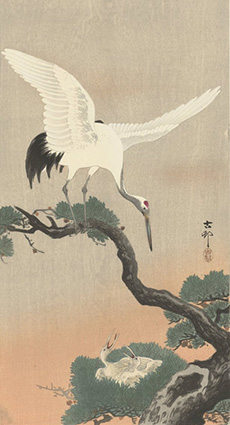
Japanese crane on a pine branch by Ohara Koson, 1900-30
Japanese woodblock print in colour
White is often used as an example to explain how a color can be received differently; it is the color of the dead in China and Japan and the color of wedding dresses in Western and Christian cultures. So, it’s true that these contextual and cultural factors come into play in our prism, but counterexamples don’t rule out the biology of our systems. In Japan, white can also be received differently. For example, walls that are frequently white are much appreciated and there is a fascination with white cranes. In the Land of the Rising Sun, the Japanese crane symbolizes peace, luck and longevity. This sacred animal is also associated with fidelity and wisdom. Many beliefs and superstitions stem from this bird of good fortune known as Tsuru. It is said that a crane can live for 1,000 years, and that a pair of cranes will ensure a happy marriage.
A breath of life
Guillaume Bottazzi – September 2024
If art insatiably nourishes our exchanges, and if the concept of art evolves with time and culture, then it is essential to question not art itself, but its effects. In this reversed light, the question of art becomes decidedly clearer, precisely because we know it demands mental engagement. Our interpretation is filtered through a lens that is closely tied to the moment in which we observe a piece, the place it occupies, the cultural symbolism of that location, the quality of those around us, the observer’s environment, and their personal experiences1. Neuroscientists seem broadly to agree on this point: art requires mental processing, and it compels us to reflect on our own conception of it. In this sense, the question of art is partially answered, since this polymorphous and reflective matter is alive and constantly shifting in the eyes of the beholder.
Gaston Bachelard asserts that space does not exist in itself, but is a product of reconstruction, adding that the intrinsic quality of a work is significant. He is right. I, too, am passionate about integrating art into people’s daily lives, especially in busy public spaces; these works become aesthetic reference points for those who frequent them, woven into each person’s lived experience. Over time, my in-situ creations become associated with memories of moments lived. They invite a form of reconstruction, because our perception is always a process of re-creation: we do not perceive the world around us as it truly is. Our perception is not a copy-and-paste mechanism: it is a reconstruction, a holistic experience. Though Emmanuel Kant addressed this point in The Critique of Pure Reason, he did not possess the tools we have today for understanding the interaction between our cognitive mechanisms and artistic experiences. There is a fruitful dialogue emerging between phenomenology and neuroscience, with many points of intersection. “Thought does not precede action, nor does action precede thought: action contains all thought,” declares neurophysiologist Alain Berthoz. In saying this, he counters Kant’s idea that art can be purely cerebral, and challenges the analytical philosophy of Ludwig Wittgenstein, which has allowed a small cultural oligarchy to preserve its dominance. That philosophy sets itself up as the sole gatekeeper of art, where only those who decipher its codes – ‘connoisseurs’– are granted access. Denying the sensory experience between artwork and audience, as analytical philosophy tends to do, obstructs art’s power to make us evolve. Art is something sensitive, something that is, and which appeals to everyone’s sensibilities. It is through our senses, through action and immersion, that we truly experience art. I recently read an article (the author shall remain nameless) which claimed that “the artist does not simply draw shapes, but his drawings are genuine committed messages.” If art is supposed to help us evolve, then this kind of confusion is troubling. First of all, artists are not moral exemplars, and we must distinguish between the individual and their work. Moreover, socially engaged art restricts the possibilities of art itself: art is a breath of life, while socially engaged art often verges on a cerebral suffocation, frequently acting as a vessel for covert propaganda – as in France – or even overt propaganda. Our societies are in turmoil; we must break free of propagandistic constraints and preserve the artist’s freedom from imposed social roles. For his part, Pierre Bourdieu said that “to get people to talk about their tastes, you have to get them to talk about what they dislike.” For him, art expresses our position in the social world, and he rejects the notion of immutable, natural beauty. According to Bourdieu, our tastes reveal more about us than our stated opinions, and the museum functions as a sacred space, akin to a church, a place of distinction separating those who may enter from those who may not. He argues that science can explain the structure of colours, but not the pleasure they give. Here, I believe he errs: we can now observe how colours affect us, track neural responses, and identify the areas of the brain activated when we look at works of art. Neurobiologist Semir Zeki found, for example, that Lucian Freud’s paintings tend to activate the amygdala – linked to fear – in most viewers. Humans need to project, to dream. Artists –who are sadly becoming an endangered species – are vital social connectors, as shown by the poet in Fellini’s Satyricon. Yet, many European institutions are mired in guilt and outdated complexes, paying a high price for it. Mathematician and Fields Medallist Cédric Villani remarked during a television appearance that, while the standard of mathematicians in Europe is high, it often goes unrecognised. Even Alan Turing, a scientific giant, was undervalued to the extent that he was advised to study under American mathematicians! Today, few artists can afford to work full-time, with most surviving on state support. To serve their role truly in society, they must free themselves from this dependency. For his part, Pierre Bourdieu said that “to get people to talk about their tastes, you have to get them to talk about what they dislike.” For him, art expresses our position in the social world, and he rejects the notion of immutable, natural beauty. According to Bourdieu, our tastes reveal more about us than our stated opinions, and the museum functions as a sacred space, akin to a church, a place of distinction separating those who may enter from those who may not. He argues that science can explain the structure of colours, but not the pleasure they give. Here, I believe he errs: we can now observe how colours affect us, track neural responses, and identify the areas of the brain activated when we look at works of art. Neurobiologist Semir Zeki found, for example, that Lucian Freud’s paintings tend to activate the amygdala – linked to fear – in most viewers. Humans need to project, to dream. Artists –who are sadly becoming an endangered species – are vital social connectors, as shown by the poet in Fellini’s Satyricon. Yet, many European institutions are mired in guilt and outdated complexes, paying a high price for it. Mathematician and Fields Medallist Cédric Villani remarked during a television appearance that, while the standard of mathematicians in Europe is high, it often goes unrecognised. Even Alan Turing, a scientific giant, was undervalued to the extent that he was advised to study under American mathematicians! Today, few artists can afford to work full-time, with most surviving on state support. To serve their role truly in society, they must free themselves from this dependency 2.
The implications are profound, and they open new perspectives for art. This concern has become a global issue, and in 2019 the World Health Organisation confirmed that art can significantly benefit both our mental and physical health. It can improve behaviour, ease psychological strain, reduce feelings of isolation, and offer comfort, happiness, and even elegance. Eric Kandel, winner of the 2000 Nobel Prize in Physiology or Medicine, has shown that abstract art stimulates the formation of more new neurons than figurative art, helping us step back and view the world differently. Henri Matisse was right to claim that “the duty of the painter is to give what photography does not.” If we truly considered human cognition in the creation of art, we could allow art to flourish in its mission to serve the greater good. When we look at a painting, we follow its lines, seeking intersections; these aid our understanding. In this sense, lines are fundamental; the audience must interact with the work. If the viewer does not appreciate the piece, cognitive activity is significantly diminished; a phenomenon neuroscientist Oliver Sacks referred to as a ‘missed encounter’.
Yet, Kandel also shows that the dissolution of lines is essential to provoke cognitive activity and the creation of new neurons. He cites the diffuse contours of Mark Rothko’s painting as a prime example. In my own practice, I work with gradients that open up space towards the invisible. The supporting medium I use creates a sense of infinity, expanding beyond the frame and thereby enhancing the artwork’s impact. It invites the viewer to reimagine what they see, triggering neural activity. Artists should strive not to impose themselves, but rather to disappear, so that the viewer may find freedom within the work and unlock its full potential for his own benefit. Neuroscientist Vilayanur S. Ramachandran’s research on seagulls seems particularly relevant: he demonstrates how our appetite for art is linked to form synthesis. This could explain the appeal of Aristide Maillol’s sculptures. Art reduces our sense of loneliness and isolation; we do not view a work of art merely as an object, but as though it were a person. It activates mirror neurons, which are the same ones triggered when we gaze at someone we truly love. This suggests that we should accompany people who suffer from loneliness, people who are going through difficult times – such as those in palliative care, for example – with works of art, or that we should install art in centres for the elderly. The powers of art are immense, and we can measure their effects through our sensory experience. The World Health Organisation itself confirms that art can reduce social tensions and contribute to mental health, so what are we waiting for?
Art must inspire us and nourish our imagination. Only through freedom can artists fulfil their role and offer society that glimmer of hope that slips through the net. Art is multifaceted; it adapts to our needs, and we, in turn, feed on its lifeblood. It is a vital force, capable of supporting our evolution, our recreation, and our individual needs. As the philosopher Marc-Alain Ouaknin has said, the richness of a work of art necessarily implies a polysemic, open form of expression.
1 I recommend reading the book Skin in the Game, by Nassim Nicholas Taleb.
2 Cf. Helmut Leder and Marcos Nadal, « Ten years of a model of aesthetic appreciation and aesthetic judgments », British Journal of Psychology, 2014.
Words mislead us
Guillaume Bottazzi – September 2023
Words mislead us, or to be more precise, they lead us to misunderstand our mechanisms.
“Words distance us from things,” said the philosopher Henri Bergson. Thus words mislead us and deny us an understanding of ourselves. They are not the product of reality, but are created by man; they are the fruit of a prediction or a projection. Words are fiction.
For example, we have invented words like ‘desire’, ‘love’ and ‘beautiful’. However, the neurobiologist Semir Zeki clearly explains that in his experience of recognising beauty, an observer borrows from areas of his brain that are the same. If our cerebral system does not distinguish between these experiences, it is because they are the same; in other words, desire, love or beauty have the same cerebral implications.
For the sociologist Pierre Bourdieu, science cannot explain the pleasure we derive from colours, but only their structures. He was wrong, because neuroaesthetics now makes it possible to understand how and why colours affect the viewer.
Our knowledge of this mechanism is bringing about a profound change in art which, long awaited by an artistic community that is not renewing itself, will enable us in the future to look at a work for what it produces and not for what it is.
I dream of a world that is no longer a brake on art, because art today is subject to the strategic implications of policies that reduce its scope.
I dream of an art that does not divide the world so that some people can claim to belong to a dominant or dominated social category.
I dream of a world where art is presented in hospitals, in health organisations and in our daily lives, so that everyone can benefit from it…
For example, we now know that when we look at a work of art that we find beautiful, it activates mirror zones that are the same as those activated when we look at a person we really like. In other words, surrounding yourself with works of art that you love helps to alleviate feelings of loneliness. This means that art is not something trivial, that it can be a factor in psychological balance.
Art is therefore a powerful vehicle for building, recreating and rediscovering ourselves: art must reconnect with beauty. This beauty does not find its essence in itself, but through the effects it has on people. The aim is to create a better world that promotes peace and love, but also generates pleasure, helps us to develop our cognitive capacities and our ability to cope with the difficulties of life, to step back from things, to strengthen ourselves, to balance our psyche, to become stronger, more creative, more elegant, more virtuous, more sociable, more likeable, more loving…
Art reconnects with beauty – more
Guillaume Bottazzi – May 2023
Art encourages love and peace
For the record…
Beauty and art were brutally separated by Marcel Duchamp with his urinal (see Fountain). Not all artistic work, however interesting, necessarily relates to the experience of beauty.
We have a filter that separates the ugly from the beautiful, with the information sent to different regions of the brain.
Neurobiologist Semir Zeki states that beauty is desire and love, and that there is a mirror association with beauty. When people look at a person or object they desire, they use the same pathway as for beauty. So there is a common area of activity localised in the medial orbitofrontal cortex; these areas are activated when one experiences beauty, but they are also sometimes active when a person looks at individuals of whom they are really fond.
Contextual deviations in a society in crisis
Today, deviations and confusions are to be avoided. Amalgamations have become common, and these shortcuts reflect the dysfunction of our societies.
– I note that beauty is sometimes perceived by some people as being reserved for the rich, and this makes art a mark of division between social categories. Studies of a population living in poor ANRU1 zones show that disadvantaged social categories want to break away from this rule, because they do not want to be associated with a social marker that presents them as belonging to a dominated class. The vast majority of people living in these areas want the same benefits as the better-off classes.
– Some of us feel that if there is an 80% of women in artists’ works, and beautiful women at that, this is the mark of a reduction in the status of women, with them being reduced to the role of women as objects. People sometimes do not know how a human being functions. All neuroscientists agree on this, but I would like to quote Anjan Chatterjee who explains in his talk “How your brain decides what is beautiful”, that a person who is considered beautiful is associated with a person who has qualities and values. For example, Sandro Botticelli’s Birth of Venus is an allegory of female beauty and purity. The recognition of beauty leads us to see the person as more intelligent, as having more values and common sense, as being deeper and more perfect…
In our appraisal, they will have more inner qualities than others.
Art must contribute to a better world
The people involved in some way in the art world represent 2% of the population. These players sometimes consider beauty to be an embellishment that hides the substance: it can be considered superficial, while bad taste, kitsch, is a claim that has remained very present in the art world. The art world has banned the word ‘beautiful’, but it has remained in the dictionary and in the collective consciousness. The study Art, Aesthetics and the Brain by the neuroscientists Helmut Leder and Marcos Nadal mentions that people who observe works of art associate them with their reference to beauty. Contrary to what Kasimir Malevich thought when he painted his Black square on a white background, the work is not the subject, but the subject is the effect it produces in the viewer.
In conclusion, Semi Zeki explains that beauty activates the same areas as love and desire, and that our brain couples these together. Art therefore inherits a primary mission for humanity, which is to promote love and peace.
Artists must make the world more beautiful to help spread love and joy, but also to strengthen our will to live and our ability to survive events.
1 ANRU: Agence nationale pour la rénovation urbaine (National Agency for Urban Renewal), which has the general goal of backing comprehensive urban projects to transform disadvantaged neighbourhoods in depth.
Space-time in art encourages the notion of timelessness
Guillaume Bottazzi – March 2023
What if we were to reconcile quantum physics or the special theory of relativity with art? Our notions of space and time imply fundamental changes in the relevance of artistic proposals.
In quantum physics, time does not exist, but the idea of duration does. All durations are different, and astrophysics, particle physics, cosmic rays, space navigation, space telecommunications and GPS or even the Shinkansen prove this. If, for example, clocks are installed on each floor of a building, they will not show the same time to within a few hundredths of a second; but of course, this does not prevent us from organising ourselves on a daily basis, since the differences will be minimal.
The philosopher François Dagognet proposes to “draw from the outside to nourish the inside“, and this must be applied to art in order to stop relying on received ideas to establish aesthetic orientations. The astrophysicist Aurélien Barrau, in his lecture “Beyond general relativity”, explains that Einstein understood that there is no opposition between container and content, contrary to what Isaac Newton thought. This roadmap implies from the outset that the arts cannot decently deny appearance without risking a form of obscurantism. Physics tells us that “appearance does not hide the essence, but reveals it: it is the essence“, as Jean-Paul Sartre1 put it, as did Sonia Delaunay in her work.
What are we in this scheme?
Space-time is a dynamic quantity, and this means that if you want to know who you are, you are not a given moment, but rather a curve. Being is to be read in terms of duration; it is a story. This would no doubt please Jacques Derrida, for whom everything is writing.
Immanuel Kant was wrong in this respect when he wrote that “time is not a concept, because it is not the simple representation of a sign common to a multitude, but contains in itself a multitude of representations, and in this sense it is a universal of a particular kind […] an infinite magnitude“2.
Marcel Proust, on the other hand, adopted time as an expandable phenomenon; for him, past and present are linked. In In search of lost time, he evokes his emotional memories, which interfere with the present.
Being is a line of the universe; it is made up of a multitude of points. There is no point in avoiding the past, the present and the future if we want to get closer to the truth. Art must be timeless and create phenomena that are transformed in the imagination of the viewer.
The implications of art are important
Which works reconcile the implications of quantum physics or special relativity with art? Quantum physics threatens time, and therefore modern art, engaged art, artivism and history painting in particular. All these movements ignore timelessness. Only timeless works bring coherence to this reconciliation.
So, if we reconcile time between art and the special theory of relativity, timelessness is the order of the day, as in the work of the painter Henri Fantin-Latour, who did not seek to be in step with his time. His art is not based on current events, but on a timeless approach.
Our living spaces
In quantum physics, space is not clearly defined: it is the result of a projection, and it is by revealing our imagination that we can create living spaces3.
1 Jean-Paul Sartre, Being and nothingness.
2 Martin Heidegger, Phenomenological Interpretation of Kant’s Critique of Pure Reason.
3 Guillaume Bottazzi, Guillaume Bottazzi et la joie d’habiter.
The limits of neuro-aesthetics
Guillaume Bottazzi – January 2023
A tour through the history of pink
I have been looking at the research undertaken by Michel Pastoureau, historian of colour: his work illustrates the history of colour in the Middle Ages or, rather, how colour has been experienced by our societies.
“For art historians, there is this notion that line takes precedence over colour, following on from Plato and Aristotle for whom colour seemed superfluous. At the end of the Middle Ages, this idea intensified until the seventeenth century, was revived in the eighteenth century and returned in the nineteenth, notably with Delacroix.”
Let’s ask this question from the point of view of fashion, for example: Why is pink for girls?1
According to Emmanuelle Berthiaud, a historian specialising in women’s history, “a few hundred years ago, pink was attributed more to men; it was considered a variant of red, marking masculinity par excellence. Since ancient times, it has symbolised power and authority. The word ‘pink’ did not exist in Greek or Latin. Instead, it was called ‘crimson’. Pink was worn during the Renaissance; it was a fashion for the elite and for men. In France, at the time of the Enlightenment, Madame de Pompadour made pink fashionable, but there was nothing specifically female about it.
From the twelfth century onwards, blue was a colour increasingly attributed to women, in reference to the blue cloak of the Virgin Mary. Children were most often dressed in white, which evokes purity and innocence. The Protestant Reformation influenced fashion and brought about changes by favouring black, brown, grey and blue. Blue was increasingly associated with power. Women, including peasant women, often dressed in red. Goethe explains that ‘the female sex in its youth is attached to pink and sea-green’. In the nineteenth century, coloured clothing became more ‘democratic’; red and blue were also used for children, in softer tones. In English-speaking countries, the use of blue for boys and pink for girls began in the mid-nineteenth century for the elite, then intensified with the development of marketing. At the end of the Second World War, pink became an established part of advertising for housewives. From 1980 onwards, our consumer society encouraged the differentiation between boys and girls, so that the older sister or brother would not pass on her things or toys to her younger brother or sister.”
For the historian Michel Pastoureau, colour is first and foremost an abstract notion. Contrary to the neuro-aesthetic approach, according to him, it is society that makes colour: it is cultural. Colour is resistant to analysis and synthesis.
In his opinion, yellow is a sunny colour associated with joy. In the Middle Ages, yellow was considered a benevolent colour; but from the end of that period, everything became brown, and yellow was associated with illness, with the colour of urine. Later, Vermeer used yellow, and the Impressionists brought this colour back into the limelight for good; the Fauvist painters highlighted yellow again, through the work of artists such as Henri Matisse, André Derain, Maurice de Vlaminck, Vincent Van Gogh. Indeed, it was the painters who rehabilitated yellow.
Pastoureau also says that the more humble social classes in the eighteenth century wore bold colours, while the elites distinguished themselves with half-tone colours. According to him, too much colour kills colour. He mentions that urban planners have sought to place large areas of bright colours in the urban fabric, and that the population asked them to remove this social marker.
From art history to neuroscience
While the history of colour is a fascinating subject, the fact remains that the historian’s approach is based on social and cultural issues, not biological ones, unlike neuroaesthetics.
Neuroaesthetics focuses on the human system as biological identity: this implies that the power of neuroaesthetics must be relativised, since cultural parameters are a part of aesthetic judgement. It also implies that the historian’s point of view and that of cognitive psychology complement each other and provide different kinds of information.
In cognitive psychology, the Western visitor to a museum such as the Louvre is faced with works that represent his idea of beauty: in other words, what is recognised as such by his own culture. The works he sees become his reference of beauty. According to the anthropologist Marcel Mauss, a work of art is what is recognised as such by a group of people.
The historian, on the other hand, has skills that belong to the past; the profession of art historian was created in order to categorise works according to ethnic groups and periods, whereas the neuroscientist focuses his research on living beings. The measurement tools at his disposal have only been in existence for a few decades. For example, this implies that psychologically interpreting the red cloak in Little Red Riding Hood would not seem a worthwhile exercise, because the story is from another era with other codes.
Does neuroaesthetics transcend cultures?
Nobel Prizewinner for medicine Eric Kandel recommends the diffuse to force cognitive activity. Contrary to what Plato thought, for neuroscience, colour takes precedence over line; more precisely, it is light that takes precedence, colour being corollary to the wavelengths that are deposited on photons.
The founders of neuro-aesthetics, Semir Zeki and Vilayanur S. Ramachandran, base their experiments on patients from different cultures and social backgrounds: their ambition is to overcome divisions and provide universal knowledge.
When I present my work in the West, I consciously and unconsciously incorporate subtleties from my culture. What about when I present my creations to a distant culture?
I work in Asia, and I know Japan fairly well, for example; but not well enough to read all the subtleties, since I was not born in the Land of the Rising Sun. In this case, my aesthetic proposal brings our cultures closer together, and the biological effects should be similar; therefore, this does not exclude the phenomena created in the observer. Thus, the strangeness and break with preconceived ideas are more favourable, but so are misreadings. For example, while white is associated with peace in the West, it is during the Japanese funeral ceremony that relatives are traditionally dressed in white, as this is the colour of mourning.
Does neuroaesthetics transcend time?
Another phenomenon seems interesting to note: when a Westerner observes, for example, a painting by Botticelli, this artist is part of his cultural heritage. However, the work observed comes from another era: an era that the viewer did not live through, and this implies that what the viewer projects is something that is not the same as what the contemporaries of the painting projected. In this case, Botticelli’s work is transformed; it is reincarnated through the viewer’s own elaboration, living in another context. Botticelli’s painting is no longer the same, but is malleable and is transformed as a function of our history. The very nature of art is to become what we make of it; it depends on the way we are pervaded by the work.
If we know the aesthetic effects produced in our contemporaries, the past belongs to historians, who strive to understand ancient civilisations. This does not exclude the appreciation of a work of art from the past, although it does not project the same as when it was created. The work of art is the result of a reconstruction.
The historian gives us an ethnological view of the world of dead people, while neuroaesthetics observes the living.
1 https://www.radiofrance.fr/franceculture/pourquoi-le-rose-c-est-pour-les-filles-9568791
Summary
Guillaume Bottazzi – August 2022
I am writing today to offer a summary of several articles, for those readers who may have not have understood – or sometimes oversimplified – some of the previous publications dealing with art1. All the following statements have been proven and none of them are in any way disputed.
We have seen in earlier articles that the artist elaborates his creation, notably with the help of a warming up of his senses, which will enable the inducement of the observer of that work to live a sensorial experience.
We have also seen in previous articles that man is an integrated being who does not exist in himself. You will then understand why the object of a work is not limited to the artist or his interiority: the work is not its physical composition, but the phenomena it creates, namely the effects produced on the observer. The experience proposed belongs to the viewer and is different for each of us. The viewer will elaborate what he or she feels according to his or her experience, needs, sensitivity, environment, social surroundings, the place where the work is presented, etc.; and since our personal experience influences our aesthetic taste, it is important to surround ourselves with works of art in our daily lives.
This sensory experience will strengthen the identity of the observer, but also his or her desire or capacity to live. Moreover, it strengthens one’s own history, one’s backbone; it facilitates one’s own re-creation, one’s ability to distance oneself from things, to feel better or well. My works are also designed to ‘dislodge’ the subject’s neurons, which are in comfort zones; they modulate neurons, which is to say that they create new ones.
In short, my works not only make the viewer more intelligent, but also happier and strengthen his or her capacity to live.
According to the World Health Organisation, works of art make us more elegant and sociable. They improve our physical, behavioural, psychological and social health by reducing feelings of loneliness: when we look at a work of art, our mirror neurons are activated as if we were not looking at an object, but at a person we love. Finally, they allow us to appropriate living spaces, because spaces do not exist in themselves.
While the sociologist Pierre Bourdieu said that American abstract expressionism is considered to be in good taste for all the dominant social classes,2 it has also been shown that this movement reduces the scope of a work of art, because here, the work is only linked to the artist, to the insula, to the artist’s interiority, to his feelings and self-consciousness. We have seen that the insula is a part of the self, but that the being is more complex.
What warms up the senses and inspiration of an artist is a correlation between the outside and the inside. Art is peripheral to the artist and his senses refer to what is outside him: his perceptions.
Moreover, in the collective consciousness art is the representation of the beautiful, and the beautiful makes us feel better. The recognition of the beautiful activates the same areas as the feeling of love; it produces a richer activity in the observer than if the work were to act only on the amygdala, for example.
Vassily Kandinsky wrote that art elevates people. For me, it carries the world, despite what we do with it today.
1 Earlier essays:
Art enhances the viewer’s cognitive acuity: “A system designed to adapt to its environment”, Guillaume Bottazzi, 2022
Art reconnects with beauty, Guillaume Bottazzi, 2021
Priorities in art, neuro-aesthetics and its orientations, Guillaume Bottazzi, 2021
The Neuroaesthetics of Guillaume Bottazzi, Guillaume Bottazzi, 2021
Guillaume Bottazzi and the joy of inhabiting, the in situ works of Guillaume Bottazzi reveal new environmental paradigms, Guillaume Bottazzi, 2020
Senses and art, Guillaume Bottazzi, 2020
Supermodern abstraction, Guillaume Bottazzi, 2020
Brain and art, Guillaume Bottazzi, 2016
2 Pierre Bourdieu – La Distinction. Critique sociale du jugement, 1979
Art enhances the viewer’s cognitive acuity: “A system designed to adapt to its environment”
Guillaume Bottazzi – June 2022

Zhu Da, Lotus flower and ducks, circa 1696, vertical scroll, ink on paper, 95.8 × 185 cm, Freer Gallery of Art. Washington
Man is an integrated mechanism
We used to think that sleep was a neurobiological phenomenon and that its purpose and structure were located in the brain.
“Everyone thought that sleep is of the brain, by the brain and for the brain. We overlook the fact that we are not brains: we are mechanisms, we are integrated. Everything we do is integrated with everything else,” explains neuroscientist Paul Shaw of Washington University in St. Louis.
The first cracks in this brain-centric view began to appear when Swiss scientist Irene Tobler noticed that cockroaches sleep unconsciously. Recently, a new discovery has completely changed the narrative. We have learned that even the simplest creatures, organisms with very little brain, also sleep. For example, a study was conducted using a hydra, one of the simplest forms of animal life. Instead of a brain, the hydra has nerve networks, the most basic nervous systems in nature. In 2021, a group of Japanese scientists demonstrated that hydras sleep. These tiny freshwater organisms are living proof that sleep evolved before the brain. More and more scientists are really looking at peripheral tissues and asking how the body can impact the brain, and how the brain can impact the body, specifically with regard to sleep regulation.
In his research, neuroscientist Paul Shaw hypothesises that there are situations that the brain cannot regulate alone; in association with the damage that has occurred, sleep can reduce the activation energy for the brain’s circuits to begin to find a solution. The idea is that when we sleep, we consume less energy. The energy we use then is used in a different way. We support functions that we could not support if we were awake. Research into the hydra offers the first of a growing body of evidence that sleep first evolved to regulate metabolism and improve a repairing function, and only later took on brain-related functions. Sleep and metabolism are closely related.
To contextualise with art: if human mechanisms build themselves in relation to their surroundings, this implies that the intrinsic nature of a thing or being is not limited to an individual. The human being is an integrated organism constituted by its environment, its microbiota and peripheral elements. The artist reveals not only his identity, but also his relationship to the elements, which are themselves constitutive of his own construction. He reveals energies that allow us to be more in tune with the world around us. The artist enables the observer to have a more harmonious relationship with things, in a global manner. This infers that the subject is not the artist, but the effects of the work on the observer*, which can facilitate his or her ability to adapt to the environment. The work of art is linked to the inside and the outside, and the mind is inseparable from the body.
* Physicist Jean-Claude Picard explains that when we look at a work of art, we separate the lines, depth, shape, colour and movement… All these factors are processed in different locations in our brain. The brain will reconstitute them in phases, in a synchronised synthesis. For hearing, there is the pitch, the rhythm of the sounds, the timbre. The many factors are analysed in different areas of the brain, are then reconstituted and so bring us pleasure or sometimes displeasure.
The human brain is unique because our system is designed to adapt to its environment
Albert Einstein’s brain weighed only 1.2 kg and that of Nobel Prize winner Anatole France 1.1 kg. That’s not a great deal but it is not the size of the brain that makes it creative. Scientist Suzana Herculano-Houzel has developed a new technology to count the number of nerves in the brain. What she measures is the number of processors, of which there are many: around 100 billion.
Recently, she measured the number of nerves in the brain of an African elephant as the elephant’s brain is huge, bigger than a human brain. Indeed, the elephant has a brain three times the size of that of a human, but most of the networks are at the back of the brain. The number of nerves in the cortex of the human brain is larger and wider than in any other being. The difference is that the human brain is very connected. This means that it has the ability to move information from one area to another very easily, which is essential for creativity.
Neuroscientist Idan Segev of the Hebrew University of Jerusalem gives an example*: “a glass involves the concept of the glass, its shape which is associated with vision, taste, touch; so when we integrate the concept of a glass, we have to elaborate and call into action many modules or modalities, which interfere with different regions located in this context in the back of the brain, in the front and in the side, and these regions have to be connected to handle different types of information, to generate language, for example.” We have 3 to 4 km of connections which represents 100 million connections, and locally we have many circuits. We develop our brain more slowly than other animals. Thirty thousand networks are activated locally. The number of synapses and connections decide the dynamics of our system: not only the connections between the different regions, but also the connections within each region.
This system is designed to adapt to its environment, and this implies that artistic expression does not limit itself merely to revealing the ‘essence’ of its creator or his life, but enables the observer to be more in tune with things in a global manner.
* In the context of the conference “The brain and artistic creation”.

Yokoyama Taikan, Gunjo Fuji, circa 1917, Shizuoka Prefectural Museum of Art
The effects of colour on humans
Guillaume Bottazzi – January 2022
Colour phenomena in humans
Colour has always fascinated mankind, but new knowledge in neuroscience and cognitive psychology is now providing more insight into its effects. Further studies are nevertheless needed to understand fully our visual system and our relationship to colour. Colours are electromagnetic waves with light being captured by the eyes using waves of different lengths produced by particles that are reflected off the objects we see. The visible spectrum for humans, which is only a small part of the whole electromagnetic range, extends only from 380 to 780 nanometres, which correspond to dark purple and dark red respectively. When the photons of light from an image are emitted, they reach the lens of the eye and focus on the retina. The retina contains four classes of photoreceptors: three classes of cones and one class of rods. The cones allow us to see details during the day and are responsible for sensitivity to contrast, colour and fine detail, but do not effectively perceive the more general components. Each of the three classes is sensitive to a specific component of the dark violet, green or dark red colour spectrum. Rods are more numerous than cones and are not very effective in daylight or in normal indoor light. Furthermore, rods do not contain any colour information and therefore do not contribute, for example, to our perception of art. Humans perceive colours with specific emotional characteristics and our subsequent reaction to them can vary with our mood. Studies are under way on this subject.
When we look at a colour, we experience emotions and sensations. Our perception is the result of reconstruction and allows us to read the space and shapes around us. This ambiguity may explain why a single colour can elicit different reactions in different people or even in the same person at different times. Specifically, the visual sensory stimulus received is immediately processed by the amygdala, located deep in the temporal lobe of the brain, which moderates emotional states, and this in turn produces an unconscious response. The brain areas of vision and other senses are connected to the amygdala, which encodes and coordinates the response of neural circuits to these emotional stimuli, integrating them also with previous individual experiences. If these stimuli are new, it learns them. In this way, the individual emotional meaning generated by this visual sense influences our emotions and consequently other aspects of consciousness, such as perception, thinking and decision-making. The prefrontal cortex is fundamental to the inhibition of the amygdala and the integration of emotional, cognitive and social information, and has some capacity to limit impulsive choices. The hippocampus is important for explicit or conscious memory of emotional events. It is also involved in retrieving newly formed information, as opposed to the amygdala which is useful for unconscious emotional memory. In particular, Eric Kandel defines the sensation; in this case, this may be understood as analogous to the concept of emotions. Antonio Damasio defines it as actions triggered by an external and largely automatic stimulus acquired in the course of evolution and involving actions performed by the body – such as facial expressions – as a consequence of the sensory stimulus. In the case of vision, it is the photoreceptors in our eyes that are stimulated. They can directly influence our behaviour. Perception is instead the next step that integrates the information our brain receives from the outside world with knowledge based on learning from previous experiences and hypothesis testing, and this becomes coherent when the brain attributes value, meaning and usefulness to it.
For Antonio Damasio the feeling is conscious: it is a neural state that occurs in the wake of an emotion. Even primordial feelings, considered as images of a person’s internal state, are based in the brain stem and play an integral part in regulating our lives. They are common to both emotions and what we call bodily feelings, consisting of images of other aspects of the organism combined with those of the internal state, and to feelings of emotion, considered as complex variations of bodily feelings caused by a specific object. Concerning this aspect, the main area seems to be the insula, which evaluates and integrates the emotional and motivational significance of these stimuli and also acts as a coordinator between external sensory information and internal motivational states. While there are many parameters that greatly relativise the objective effects of colour on an individual, studies do nevertheless show conclusive statistical results.
Light
Our perception is the result of a reconstruction allowing us to read the space and shapes around us. If colour is related to wavelengths, this implies that light comes before colour. Luminosity is the origin of our vision of colour and therefore the same object, depending on the time of day or the season in which we see it, may present different colours. However, if we see the same object, we can still recognise it and our brain associates it with the colour we are used to seeing. This ability of colour to persist is essential for an object: it is a mental reconstruction called colour permanence. If this property did not exist, we would not distinguish the different elements; colour does not belong to a reality of the world but is a reconstruction. Our ‘precariousness’ in seeing elements produces elaborations that change from one individual to another. We must also bear in mind the fundamental principle of our brain’s functioning, which takes in information from the outside world and then has this completed by the person seeing. This incompleteness produces different interpretations that change from one individual to another. Thus light is effective on an individual and produces powerful chemical effects. The light is immersive as the observer reduces his or her iris to adapt to the light flow. In front of a luminous work of art, the observer is an actor of what he sees, facilitating its projection. We can imagine that glass, for example, facilitates the warming up of the viewer’s senses and his appropriation, insofar as it creates light reflections and a mirror effect.
Colours
Colour produces effects that influence our energies. Colour has a powerful effect on humans, producing effects that influence our wellbeing. Decades of research have led to a better understanding of its effects. Studies are being developed which aim to encourage consumers to buy by influencing their choice of colours. It is known that the choice of specific colours for the walls of a shop has a specific purpose. Red is a strong, optimistic and invigorating colour. Statistics show how much this colour influences our behaviour. A sportsman wearing a red jersey is more likely to win than another. Red is associated with winning and power. Red is the colour of decision-makers and induces a feeling of good energy. This colour contributes to feeling in a good mood. Red is recommended for meeting rooms, festive places, reception rooms, cinemas, theatres and concert halls. The show will be better appreciated if the environment is red. Also, when a man sees a woman dressed in red, his heart rate increases and she will be more successful than another woman. For example, red generates warmth and attracts, so it is often used in shop windows. Pink is an optimistic and soft colour. This colour will make you feel good. The softness of the colour is calming; it brings peace. Successful experiments have been implemented as a result of painting prisons pink: the experience is proving positive in calming inmates. Pink is also recommended for schools. Green helps re-order the mind: it allows us to concentrate and to find ourselves. This colour brings us back to nature, to our natural environment. It promotes calmness and organisation. This colour is suitable for libraries.
In the interior walls of shops, blue may be preferred, as this is a colour that relaxes and encourages customers to choose calmly. Blue clears the airways and purifies. It encourages our imagination. It is the colour of creativity. Experiments with children show that blue promotes creativity. It is used for brainstorming sessions in companies. Yellow, on the other hand, stimulates the digestive system. It is a sunny, positive and optimistic colour that tends also to make us feel good.
Memory and the recollection process in visual perception
It is important to bear in mind the ways in which the memory process develops, taking into consideration first of all the notion of memory, which is no longer seen as a static store of information over time from which it is possible to retrieve information in an unchanged way, but which, on the contrary, is now seen as a dynamic and reconstructive object on which depends our capacity to recall and transmit to others the content of memories. The memory device uses two processes: that of learning and that of memorising. Both procedures have phases of encoding, consolidation, storage and retrieval. Specifically, when an external stimulus selected by our attention arrives, it passes through our short-term memory, or, as Alan Baddeley calls it, our working memory, or ML, which temporarily stores information while simultaneously processing it to perform mental tasks. The working memory is articulated through a phonological circuit or articulatory loop which is used for the processing and maintenance of verbal and acoustic information, a visual-spatial notebook which is more responsible for the processing and maintenance of visual and spatial information, and a central executive system which coordinates the activity of the previous two systems, interacting also with the rest of the working memory. At this stage, the information is compared with the long-term memory before providing a definitive response. Long-term memory, depending on the knowledge to which it must refer, can be explicit or declarative when accessing information consciously; this in turn breaks down into episodic memory (personal experiences) and semantic memory (a repertoire of general knowledge stored on the basis of its meaning and the input of knowledge that the individual enters as a result of his or her experiences). On the other hand, non-declarative or implicit memory (where access to knowledge is not conscious) is in turn divided into procedural memory (unconscious ability to do something), conditioning memory and priming memory. It is possible to say that higher brain regions can influence lower ones and this allows us to explain easily how something new we have just seen in an image can remind us of something else seen previously, in an effect of so-called family memory. Memory is essential for perceptual and emotional response, especially in the case of short-term memory, and visual information is perceived by the inferior temporal cortex which is analysed and then transmitted to the prefrontal cortex which codes the behavioural response. Long-term memory, on the other hand, requires the involvement of the temporal lobe, the hippocampus in explicit memory, and the amygdala and striatum (which is involved in reward and expectation) in implicit memory.
Colour and smell
Colours can also create smells that are reconstructed by humans. An experiment to this end was carried out using washing powder. Red, then blue and then yellow were added to a white detergent. The many housewives who tested the products all came to the same conclusion: the red detergent worked very well, but it was too strong because it attacked the laundry. The yellow detergent did not clean so well and the blue detergent was perfect but above all it smelled good, unlike the others. Of course, it was the same detergent in every case.
Colour and sound
Studies have been undertaken in synaesthetic areas where, for example, colour is combined with music to help persuade the consumer to buy. There is also research that shows how our perception of a food or the smell of a food is partly influenced by the way it is illuminated and therefore by the colour it reveals when presented at table. Even the colour of the dish in which the food is served and the ambient lighting can create different impressions, with the food appearing more or less attractive or abundant as a result. For humans the colour of objects is essential in terms of marketing and advertising strategies. Indeed, using other terms to express this notion, according to Jean-Marie Floch, when we stand before an object, we perform semantic operations and in particular valorisation, which is to say we construct values that we individually attribute to this object. The term valorisation identifies the operation of that part of the world we want to analyse and which is obtained through appropriate semantic mediations that combine a certain object with our experience of the world.
Research conducted by the Institute for Color Research in collaboration with the University of Winnipeg has shown that consumers require only 90 seconds to make a judgment about a product with reference to its value and reliability. This colour accounts for 62-90% of this result. Therefore, various theories and research show that colour is able significantly to influence attitudes and perceptions of a brand.
Art reconnects with beauty
Guillaume Bottazzi – December 2021
The philosopher Edmund Burke wrote in 1757 that beauty “is most often some quality in bodies acting mechanically upon the human mind by the intervention of the sense”. Burke thus distinguished art from beauty; but beauty and art were later brutally separated by Marcel Duchamp, with his urinal (see Fontaine). Thus, not all artistic work, however interesting, is necessarily linked to the experience of beauty.
Neurobiologist Semir Zeki explained in his lecture “The Neurobiology of Beauty” that there are no specific characteristics to define beauty, so in his experiments on beauty he targeted individuals representing different ethnicities, cultures and upbringings. Semir Zeki excluded ‘insiders’, such as painters or musicians, so that knowledge of the subject would not influence the answer. His idea was to show paintings and play music so that everyone could assess the beauty they sensed. Then he scanned the subjects and showed them the same works again, this time monitoring brain activity. The flow of blood detected by the scanner allows us to see the activity and the areas stimulated. He conducted these experiments using a painting by Jean-Auguste-Dominique Ingres that most people (but not all) like – La Grande Odalisque – and another painting that many (but not all) people consider ‘ugly’, painted by Lucian Freud – Benefits Supervisor Sleeping. This work does not provoke an experience of beauty for most subjects. In music, a majority found Gustav Mahler’s Fifth Symphony ‘beautiful’, and many subjects described a work by György Ligeti as ‘ugly’.
By observing the stimulation of brain activity, and especially the areas that are active when subjects experience beauty through the eyes, we notice that in addition to the visual areas, the medial orbitofrontal cortex – the emotional area – is also active.
In musical aesthetic experiences, the orbitofrontal area is very active. There is also an isolated area that is mobilised, which is always corollary to the experience of beauty. There are characteristics that define beauty, but the response comes from the brain and not from the artworks. In recognizing the beauty, there is a strong activity in the relationship to the work: the intensity of the experience is great for the observer.
But what about ugliness? Faced with ugliness, the observer also activates stimuli, but differently. The amygdala is active, and the cortex mobilises the motor that protects us against ugliness. The essential function of the amygdala is to ‘decode stimuli that could be threatening to the organism’. Joseph LeDoux, director of the Center for the Neuroscience of Fear and Anxiety in New York, illustrates the action of this circuit very well: “A hiker in the wilderness sees what he thinks is a snake. The short circuit activates an instantaneous jolt and recoil response of fear.”
We have a filter that selects between the ugly and the beautiful, and then sends the information to different parts of the brain.
Semir Zeki affirms that beauty is desire and love, and that there is a mirror link with beauty. When people look at a person or an object they desire, they use the same pathway as for the beautiful. So there is a common area of activity located in the medial orbitofrontal cortex, and these areas are activated when we experience beauty; but they can also sometimes be activated when a person looks at individuals they really like.
If, for the observer, the beautiful reinforces his or her desire to live and stimulates more activity than the ugly, this implies that a work of art must stimulate our desires, love and beauty. The significance of a work of art is therefore not measured by itself, but by the effects it produces in the viewer.
Priorities in art, neuro-aesthetics and its orientations
Guillaume Bottazzi – September 2021
Since many people in the art world seem to lose themselves in a compartmentalised world and in preconceived ideas, and since scientists do not always understand what is at stake in art, it is important for me to give my point of view as an artist.
Look around you: we are heirs to various issues that make our world seem chaotic. Paradoxically, we are also becoming aware that we are in an ecosystem, and that this ecosystem is itself part of another ecosystem. Consequently, there is no ‘I’. This is not chaos: everything is connected and the work of art is a bridge between the microcosm and the macrocosm.
The history of art seems to reveal a shared interest by artists to draw closer to the public. In the Renaissance, we discovered Donatello’s sculpture in the Piazzale degli Uffizi in Florence freeing itself from its pedestal. Later, Baroque artists introduced movement into the work of art, to solicit the viewer’s fascination. Thus, as the German author Karl Philipp Moritz wrote, the work of art presupposes the experience of the viewer.
Neuroscience allows us to bring the work of art even closer to its audience; and this search for proximity is important because what makes a work come alive is the observer’s elaboration of it. Nevertheless, the priority lies elsewhere.
Donatello or Rubens, for example, drew closer to the audience, as we explained earlier; however, they also sought to elevate the viewer, unlike the recent work of Jeff Koons (to name but one) who seeks to draw the audience in, but not to elevate it.
Vassily Kandinsky considered with good sense,that the work of art elevates us spiritually; this elevation is measured by the tools we have today. However, over the last 20 years, our cognitive capacities have been regressing and we must therefore place our cursor on the optimization of human potential.
The work that prevents the viewer from thinking for himself atrophies the fields of possibility in art, insofar as it is the observer’s elaboration that allows him to facilitate the modulation of his neurons1. Thus, narrative art forces the viewer into a passive role and limits his own elaboration, and figurative art limits our cognitive activity, etc.
Therefore, the work of art has the vocation to stimulate our imagination and to encourage our initiatives.
It must encourage the onlooker to elaborate.
This implies that the work is opposed to capture or control, as Marc-Alain Ouaknin describes it in Éloge de la caresse (2016); on the contrary, it encourages us to travel, to build, to recreate, to evolve, to strengthen ourselves, constantly linked to the inside and the outside.
While we are embarking on this new era – called the ‘Anthropocene’ – with so many problems, we nevertheless have information that could allow us to readjust our orientations.
1 Eric Kandel, Reductionism in Art and Brain Science – Bridging the Two Cultures, Columbia University Press, 2016.
The Neuroaesthetics of Guillaume Bottazzi
Guillaume Bottazzi – March 2021
Neuroaesthetics is an empirical aesthetic. The discipline aims to study the aesthetic perceptions of art from the point of view of science. François Dagognet wrote: “Drawing on the outer rather than on the inner”1, and this approach must be applied to art which, by feeding on the neurosciences, changes its paradigm. Neuroaesthetics is a renaissance of art; it marks a great turning point: the shift from one world to another.
Neuroaesthetics uses knowledge from the neurosciences, which allows us to understand better the effects of a work of art on humans and to optimise these. This approach involves a study of the phenomena with the aim of optimising the virtues of a work of art. Thus, in contrast to modern art, the work escapes any doctrine of speculative, hazardous and closed belief, since it is based on observed facts or effects. Neuro-aesthetics makes it possible to optimise the benefits of a work of art, and thus to widen its scope.
Arbitration
Today we can recognise, or not, the relevance of artists. For example, Vassily Kandinsky wrote that art allowed us to rise spiritually;2he was right, because we can – thanks to neuroscience – see that art creates cognitive activity and modulates our neurones.
In Art and Reductionism, neuroscientist Eric Kandel explains why abstract art stimulates our brain activity. He states that an abstract work, and what is more one with diffuse contours, will produce greater brain activity in the observer. The painter Henri Matisse was also right when he wrote that “the role of painting is to give what photography does not”.3
In A Psychological Look at the Art of Guillaume Bottazzi,4 the neuroscientists Helmut Leder and Marcos Nadal show why my works tend to promote well-being. Well-being has a connotation that is misperceived by a category of people, but this is because they are unaware that if a work does not arouse empathy, it simply creates little or no cognitive activity.
Immersion
The size of the works draws the viewer into an immersive sensory experience, allowing him to record it in the register of his personal experiences. This explains why my creations tend to be larger than a person. Moreover, the installation is not a peculiarity of our time, since we benefit from a heritage of immersive works, such as cave art or Italian frescoes for example.
Neurosciences allow us to anticipate the future
For example, since we know that our perception is global, the consequence is that works of art will integrate into our daily life with devices in-situ that will no longer be made from bits of string, contrary to what we can sometimes observe in contemporary museums and art centres.
Phenomenology
The German writer Karl Philipp Moritz was right when he wrote that the work of art assumes the experience of the spectator. The work of art is not science, but it uses science to move forward. The work of art is a plastic and malleable material.
1François Dagognet – Changement de perspective : le dedans et le dehors (A change of perspective: the inside and the outside).
2Vassily Kandinsky, Concerning the spiritual in art.
3 Henri Matisse in conversation with Georges Charbonnier in a television programme called “Couleurs du temps” broadcast in 1951.
4 Helmut Leder and Marcos Nadal – Curved art in the real world: A psychological look at the art of Guillaume Bottazzi.
Guillaume Bottazzi and the joy of inhabiting
Guillaume Bottazzi – November 2020
The in situ works of Guillaume Bottazzi reveal new environmental paradigms
Why having dreamlike spaces in our everyday spaces?
The in situ works of Guillaume Bottazzi modify our environment and cause new architectural paradigms to emerge.
For Gaston Bachelard, imagination constitutes the foundation of reason and perception: this is the reason why imagination takes precedence in the creation of the spaces we occupy, since – above all – we inhabit dreamlike spaces. Our imagination conditions our perceptions and our thoughts.
These poetic spaces are not places that exist in themselves. They are not an envelope in which we come to be buried and nor an objective container of elements. These poetic spaces nourish our creativity and stimulate our construction.
My in situ works create dynamic spaces, spaces inhabited by the living, always connected with the outside and the inside. These creations create spaces that transcend lines and utilitarian space.
Imaginary spaces
It is the concrete and matter that will reveal our dreams and the spirit of places. It is they that will stimulate a personal imagination; and in order to be able to dream, we must not rationalise.
For example, if we look at the building plans for a construction, we do not dream, but if we reinvent what we are looking at, we appropriate the site. To do this, we need to seek out anything unexpected in it so as to be able to inscribe the spaces we frequent into the register of our imagination.
Every landscape is an experience that connects with our imagination, and this imagination is not a passive daydream but takes shape in action, in the way a child walking along a line on his way to school pretends he is tiptoeing on the edge of a high precipice.
The spaces frequented nourish the passer-by with a form of unreality and make him dream.
Creating evolving spaces
The three-dimensionality of static spaces is an illusion.
New physics and quantum physics induce the idea that all space is evolutionary.
New physics calls into question the three-dimensionality of static spaces; this is the case of the “theory of relativity” whereby static space does not exist, but it is also the case of quantum physics for which things are no longer locatable.
New physics has revealed a new dynamic of space, where dream space is the construction of a dynamic space bringing the joy of inhabiting a given place.
It is a space that is constantly changing, an open space that is never closed, a space that evolves and surprises.
An objective evaluation of the beholder’s response to abstract and figurative art based on construal level theory
Celia Durkin, Eileen Hartnett, Daphna Shohamy and Eric R. Kandel – June 2020
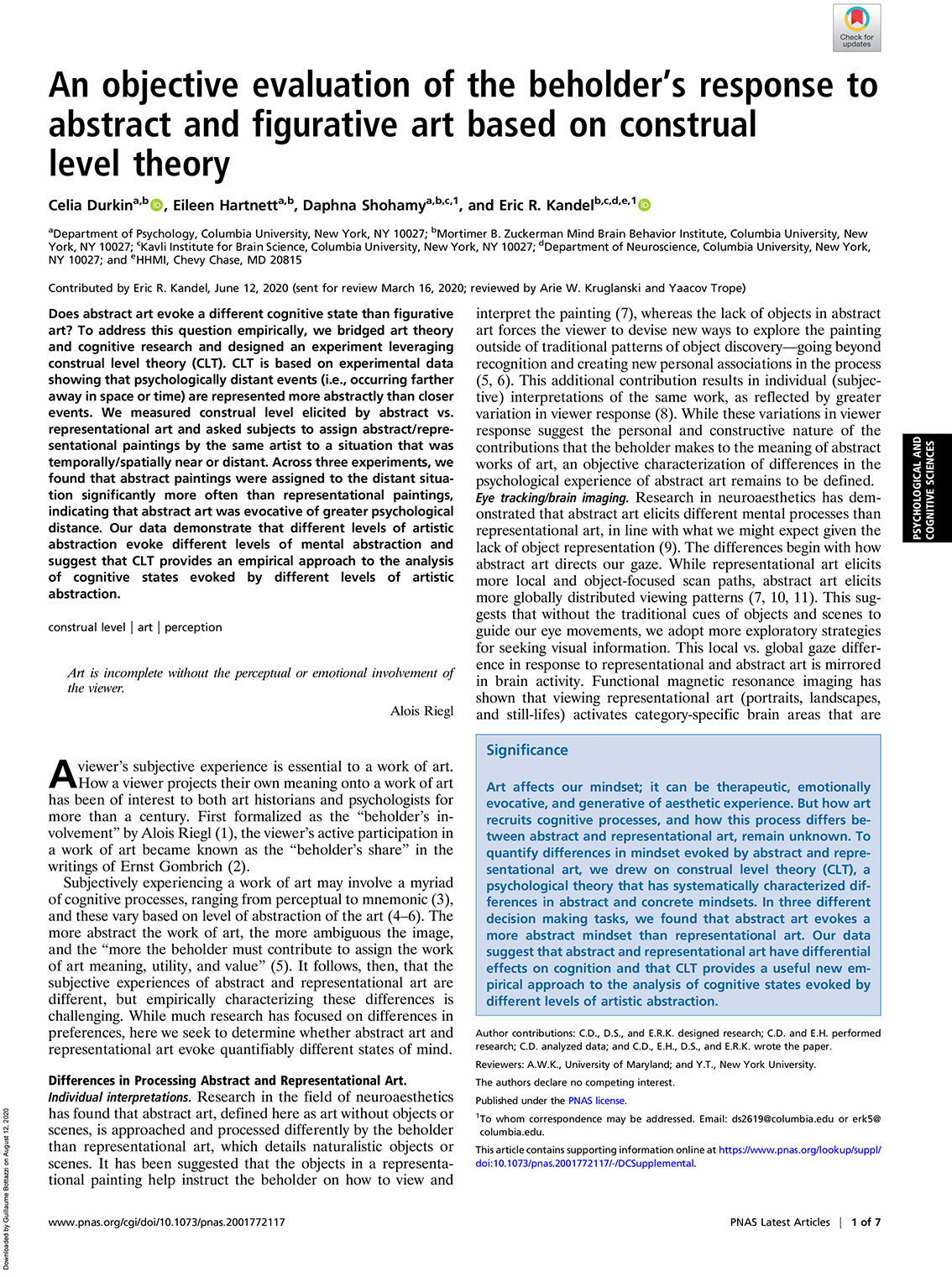
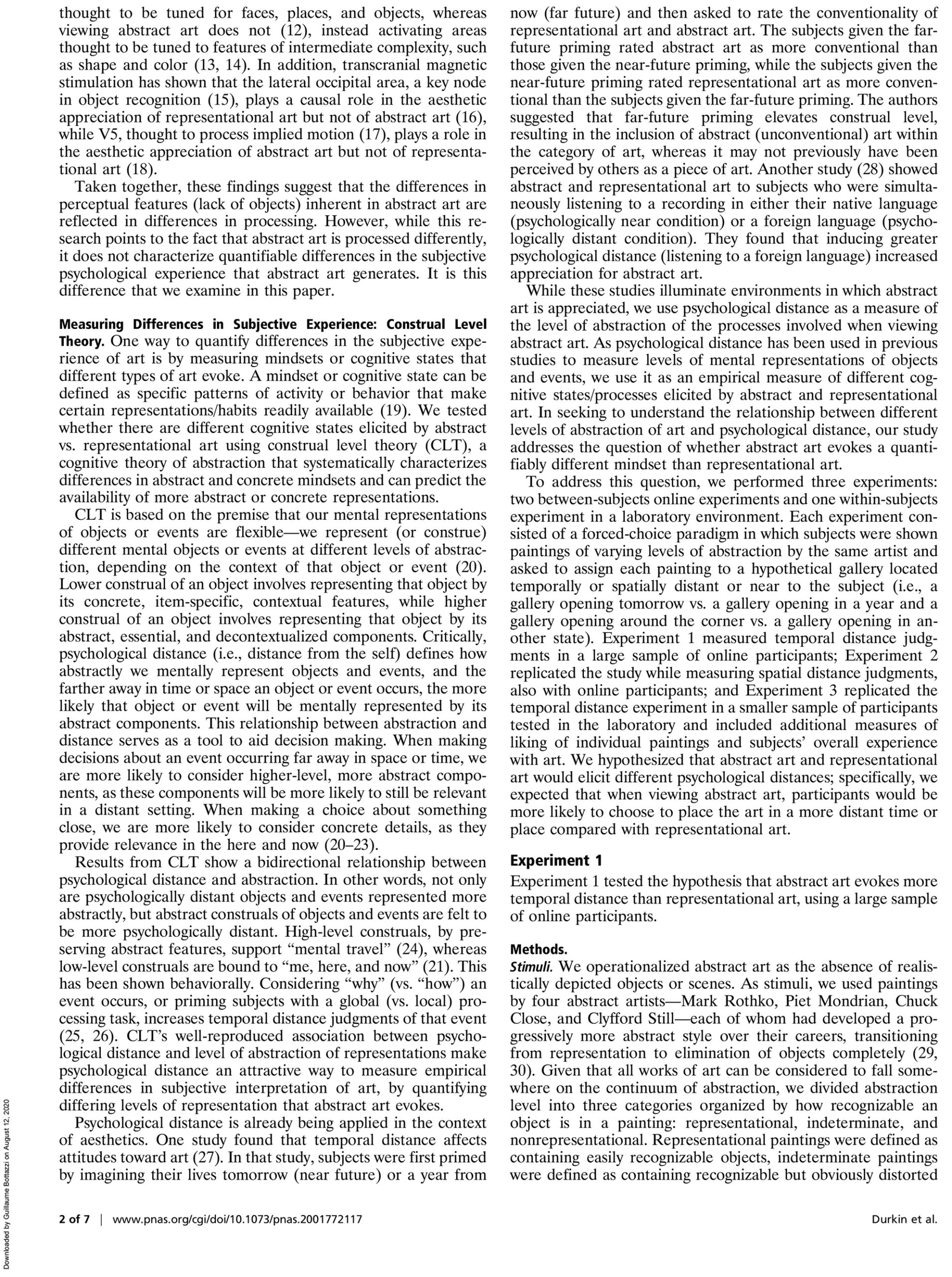

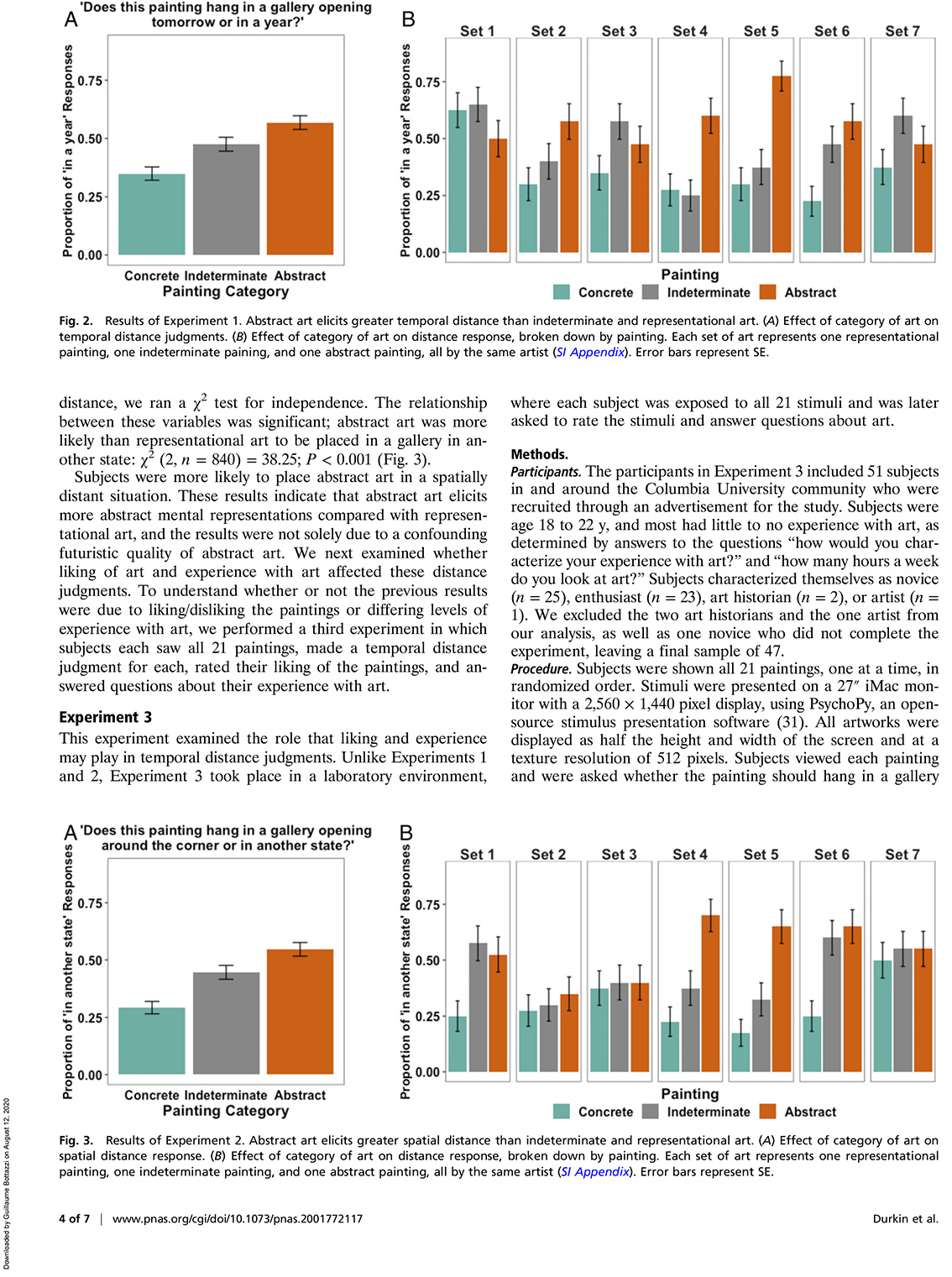
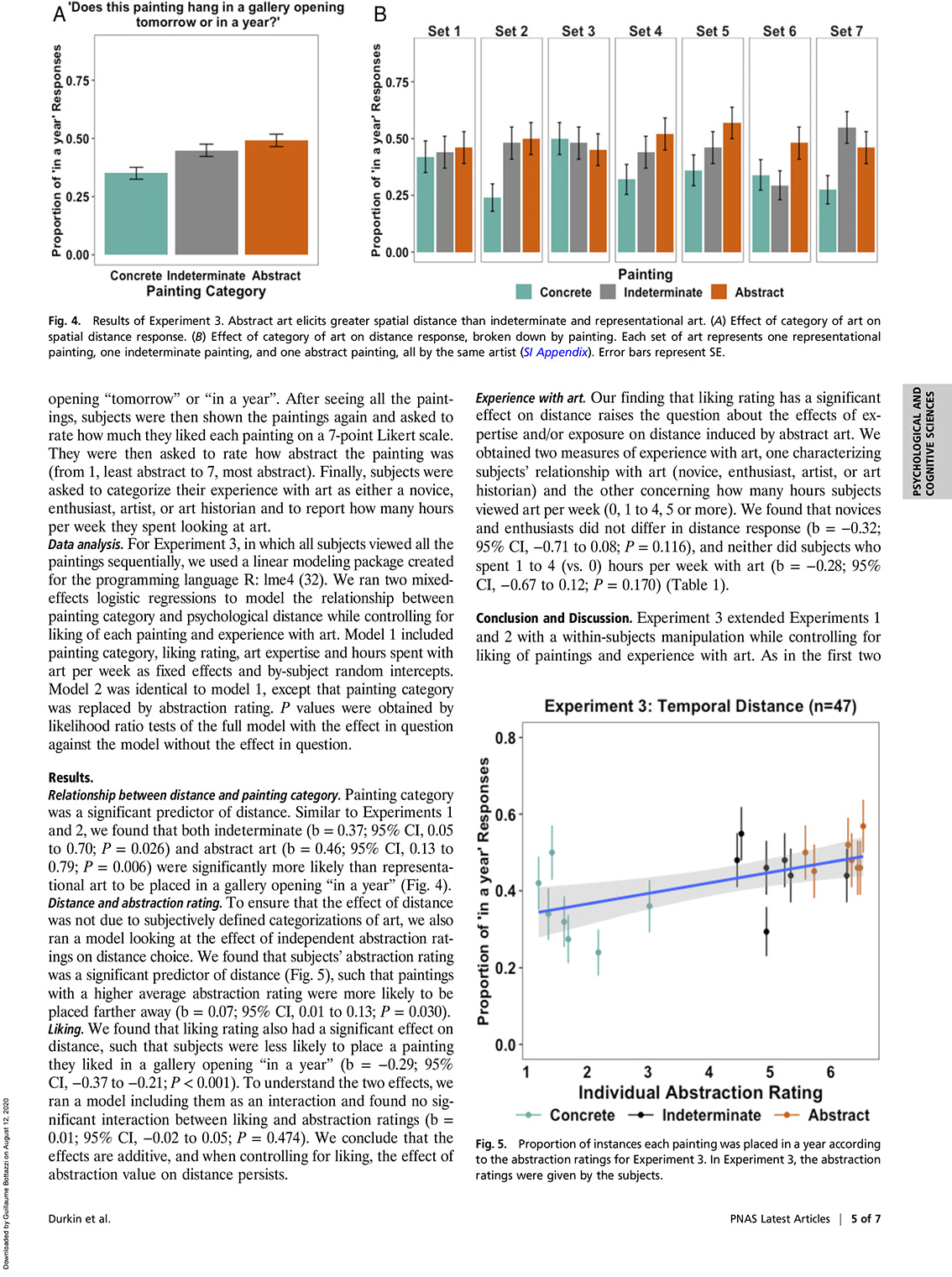


Senses and art
Guillaume Bottazzi – March 2020
The analytical approach in the art world is established in the naming systems; it has become a form of classification that has gained weight and which serves as a reference in the context of the artistic judgement of initiates. This current of thinking was initiated by Wittgenstein, and others have since taken it up.
To introduce the subject and summarise the situation, the analytical approach seeks to destroy the sensory dimension of a work of art, maintaining that our senses offer only a reading at a first level. It considers that art has no essence. This leads those who implement this approach to consider that the meaning of a work of art can only be understood by intermediaries, that is to say, themselves. Thus, these players set themselves up as the only link between the public and the work: this explains how these intermediaries perpetuate their jobs.
The problem with this social elaboration in the art world is that it operates at the expense of public interest, but also of art since it freezes it. The analytical approach in art reduces the scope of artworks, even though the work of art is a malleable, flexible medium: we reinvent the artwork we look at over time.
What Marc-Alain Ouaknin says in Lire aux éclats, éloge de la caresse should be applied to art too, which opposes taking possession or controlling, and allows us to evolve. That is why, from Antiquity to the present day, art has been the subject of never-ending reflections. As Vassily Kandinsky1 put it, “art enables you to rise”.
For Nobel Prize laureate Eric Kandel,2 in Reductionism in Art and Brain Science – Bridging the Two Cultures, art modulates our neurones and it is the cognitive activity of the observer that enables this to happen.
Cognitive activity is the measure of the production of grey matter and of our spiritual elevation. The study by Oliver Sacks, the British doctor, neurologist and writer, “The effects of music on the brain”, presents an MRI which measures the effects of music on the public.3 It shows that if the listener is not sensitive to the music he is listening to, music creates hardly any cognitive activity. However, if the listener likes the music he is listening to, there are many areas that activate. If the viewer is not receptive to the observed work of art, it will have no effect on him. The scientific data seem to agree, because they imply that an approach that denies the sensitive in art also negates the activity of the brain, insofar as it will then develop only in a very reduced way. On the other hand, artworks that appeal to our senses have the power to immerse us and create an aesthetic and cognitive activity.
In a ten-year research on the brain and art,4 Helmut Leder and Marcos Nadal explain that the viewer may find criticism of a work pertinent, but that this will not affect his aesthetic judgment.
On the other hand, in his article entitled “L’esprit est modelé par le corps”,5 the neuroscientist Antonio Damasio demonstrates to what extent the body is inseparable from the brain, and how the latter is able to determine our aesthetic judgment, sometimes without filters.
In other words, to deny the sensory dimension of a work – and even its essence – is like amputating one’s limbs before playing a game of basketball.
1 Vassily Kandinsky, Concerning the Spiritual in Art, 1911
2 Eric Kandel was the 2000 Nobel prizewinner of physiology or medicine
3 Oliver Sacks, The Effects of Music on the Brain – https://www.youtube.com/watch?v=AUT9UTVrwp8&list=PL8FKI9WbQ5tR6S00K4n5Lwn7IgbFLapst
4 Helmut Leder and Marcos Nadal, Ten years of a model of aesthetic appreciation and aesthetic judgments : The aesthetic episode – Developments and challenges in empirical aesthetics, 2014
5 Antonio Damasio, La Recherche, n° 368
Supermodern abstraction
Guillaume Bottazzi – January 2020
The art historian Hans Belting1 suggests calling today’s arts “supermodern” art.
In order to broaden the impact of art, a poetic commitment is a constant in all my works.
The subject is the work of art itself, it is polysemic and surrenders itself to the observer’s elaboration. The work is not limited to a cause that is external to it, that would reduce and fix it, but optimises the effects generated in the observer.
According to the philosopher Martin Heidegger2, a work of art is a power that opens and “installs a world”. It is not a simple depiction, but the manifestation of the deep truth of a thing. Art is itself origin and creation of the world. Art reinvents the world, exalts it, and participates in its transformation. And in fact, art takes part in our development in all things. Numerous writings have illustrated how art is a subject of reflection that has never stopped changing and causing controversy through the centuries, because art is malleable, because it is an intangible and soft matter. The painter Vassily Kandinsky considered that art allows one to raise oneself3. For him, spiritual life is a movement that corresponds to the movement of awareness. In his “essay on the imagination”, Joseph Addison, a seventeenth-century English writer demonstrated that the works we see become part of us and express themselves in the world of the observer4. The convictions of this author are today scientifically proven, notably by the research by the Nobel Prizewinner in physiology, Eric Kandel, who shows how our brain develops in recreating the work of art we observe and why abstract art modulates more neurons than figurative art5. For the painter Paul Klee, “art does not reproduce the visible, it renders visible6”. To paint is to hide, to induce the non-visible in order to optimise the observer’s own elaboration. This leads me to share my liking for the painter Henri Matisse with you because he understood that “the painter’s duty is to give that which photography does not give7”.
The philosopher François Dagognet wanted to “go outside to plumb the depths rather than inside8” while the neuroscientist Antonio Damasio demonstrates that “the mind is shaped by the body”, that it is not only the brain that is mobilised when we look a work of art but also the body9.
Moreover, in his ten-year research on the brain and art10, neuroscientist Helmut Leder of the University of Vienna in Austria has shown that the notion of art is closely linked to each person’s personal experience. This partly expresses my interest in large formats, in environmental creations and installations, since they immerse the spectator, inviting him to move around and add what he sees to the register of his personal experiences.
In a study, two neuroscientists, Helmut Leder and Narcos Nadal, prove that my creations contribute to the well-being of the viewer11. They promote dopaminergic activity and reduce anxiety. The fact of loving a work, of feeling good before it is the factor that will enable it to play its role, as research by Antonio Damasio has shown.
When I visited the Ryōan-ji temple in north-west Kyoto, I sought a global approach, one that incorporates different parameters and gives the impression of infinity. I have abandoned the form and expression of the artist who focuses on himself. I have painted in such a way as to find my own breath, a balance that centres on the energies deployed.
Art must leave the well-trodden path, renew itself, bring the unexpected, surprise us. It must lurk where we do not necessarily expect it, accompany us on a daily basis, transform and reincarnate itself.
1 Hans Belting – The End of the History of Art?
2 Martin Heidegger – The Origin of the Work of Art
3 Vassily Kandinsky – Concerning the spiritual in art
4 Joseph Addison – The pleasures of the Imagination, le Spectator
5 Eric Kandel – Reductionism in Art and Brain Science
6 Paul Klee – On Modern Art
7 Henri Matisse – Interview with Georges Charbonnier in 1951 in a programme called “Couleurs du temps”
8 François Dagognet – Changement de perspective : le dedans et le dehors (A change of perspective: the inside and the outside)
9 Antonio Damasio – La Recherche, n° 368
10 Helmut Leder and Marcos Nadal – Ten years of a model of aesthetic appreciation and aesthetic judgements: The aesthetic episode – Developments and challenges in empirical aesthetics
11 Helmut Leder and Marcos Nadal – Curved art in the real world: A psychological look at the art of Guillaume Bottazzi.
Cultural engagement and incident depression in older adults: evidence from the English Longitudinal Study of Ageing
Daisy Fancourt and Urszula Tymoszuk – 2019
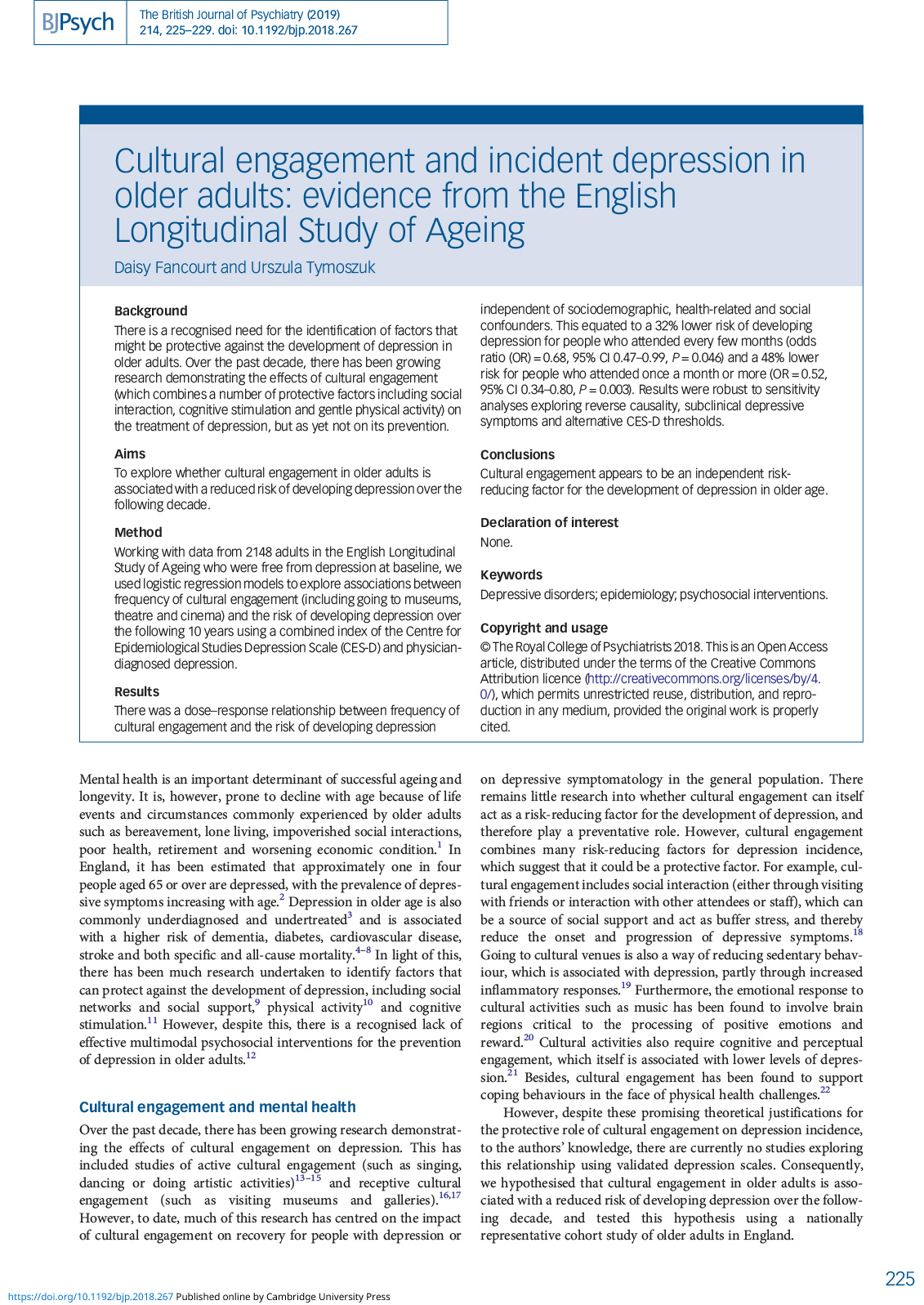
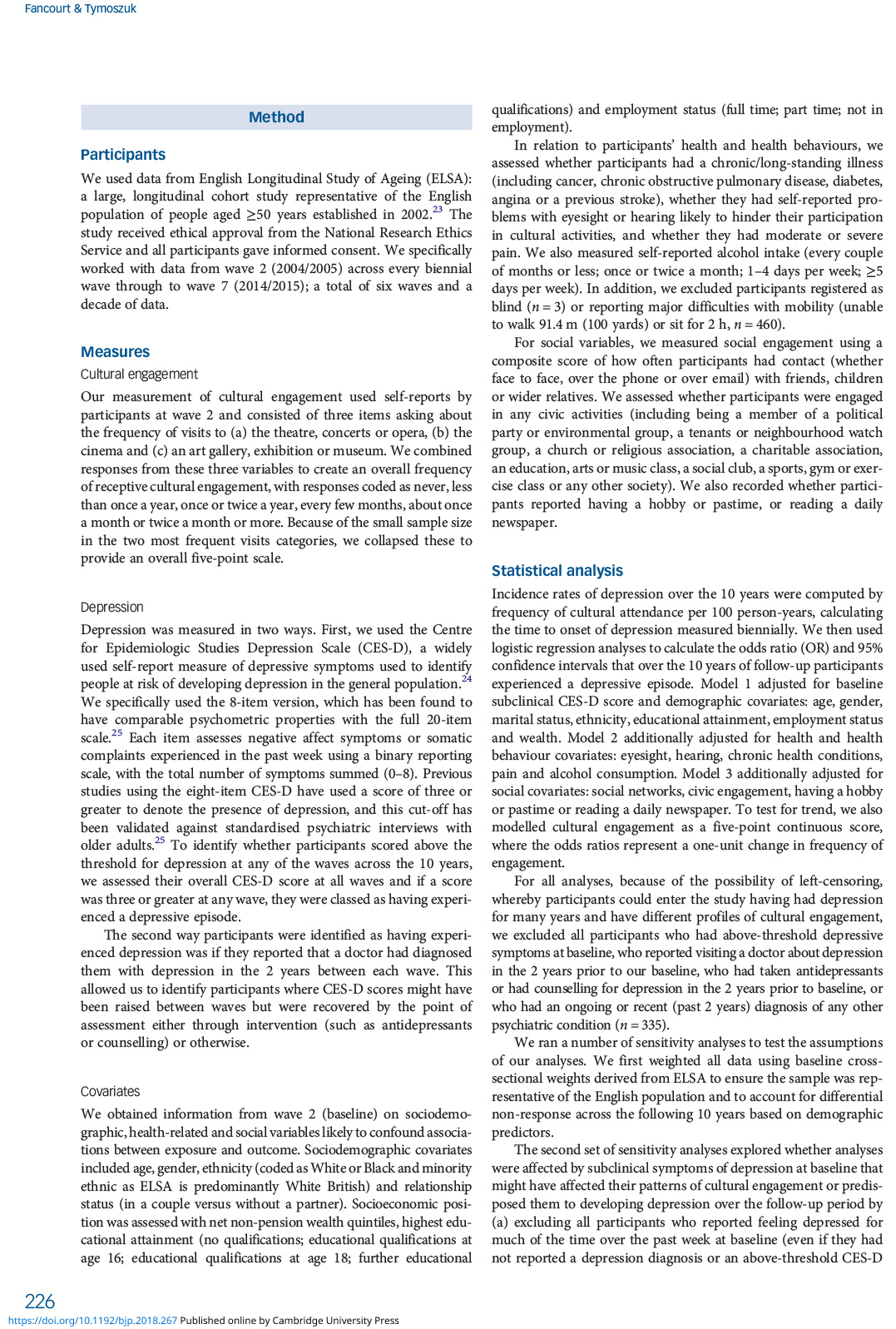

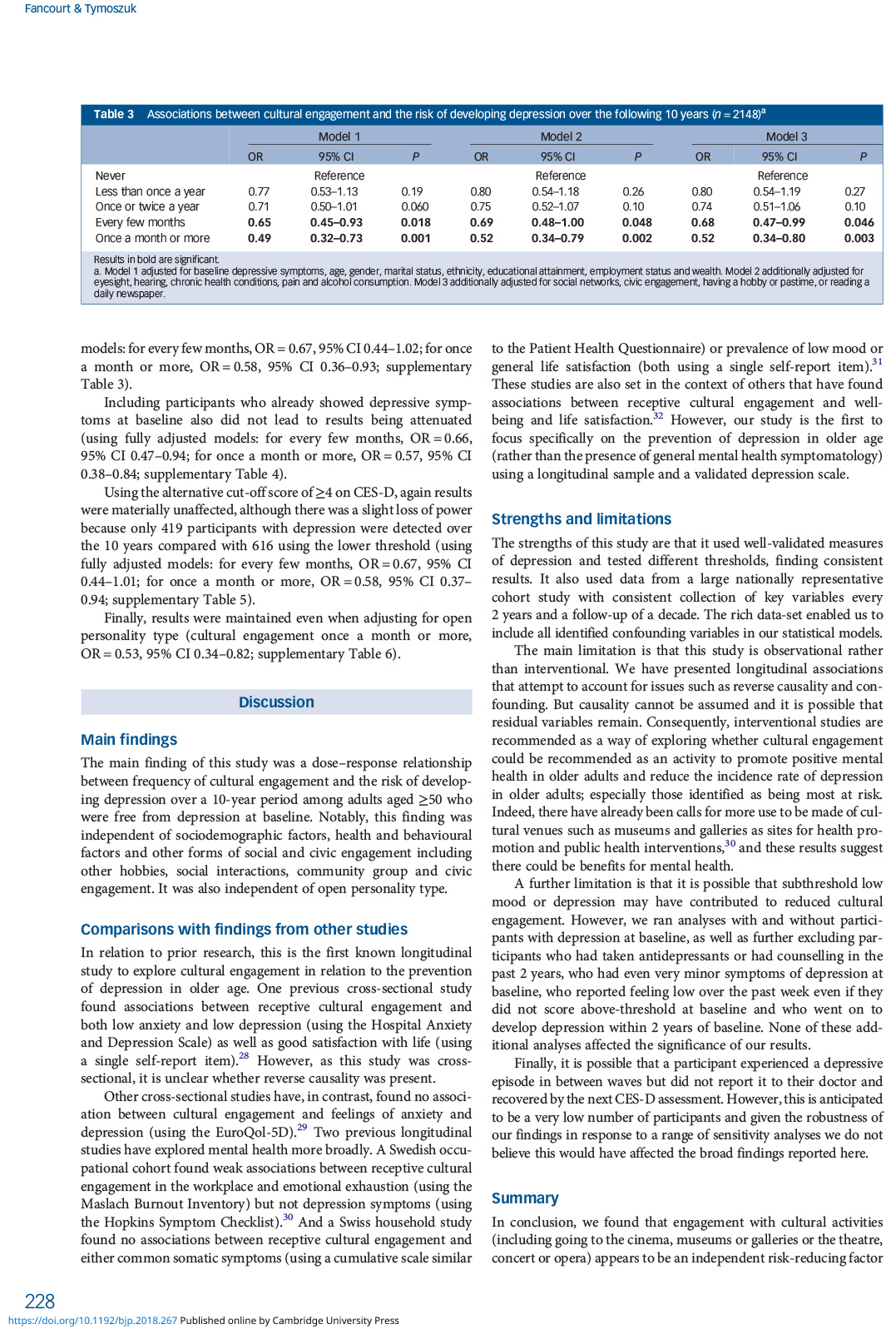
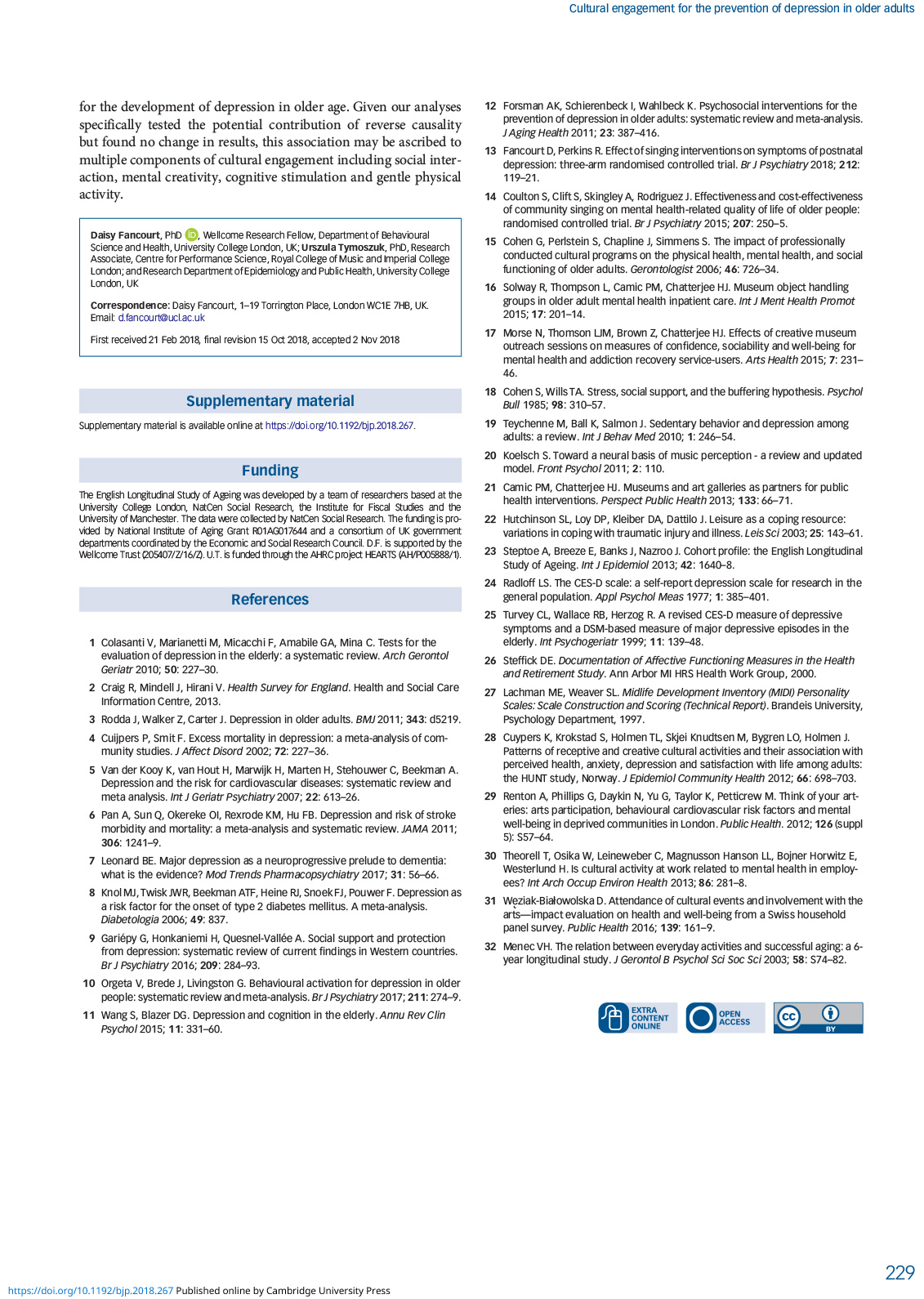
Brain and art
Guillaume Bottazzi – January 2016
Sensory perception is created by arousal or stimulation which itself produces a reaction.
We are able to see an object only if the information passes through the cortex.
That explains why our vision is not simply a mechanical phenomenon but is also connected to mental elaboration.
The perception of a form induces the perception of meaning (a symbolic process); according to Gestalt theory, in an abstract image the whole perceptive system prevails over the sum of its parts.
Excerpt from the “Abrégé de psychologie” (“A compendium of psychology”), by J. Delay and P. Pichot, 4th edition, Editions Masson – Chapter IV / La perception.
Aspects psychologiques et psychopathologiques (Perception. Psychological and Psychopathological Aspects) / page 55 (translated here).
c) The Tau and Gelb Effect. – It combines the two preceding series.
When three equally spaced bright spots A, B and C are presented one after another and the temporal interval between A and B is inferior to that between B and C, points A and B are seen as closer together than B and C.
A few optical-geometrical illusions. On the upper left side, the Müller Lyer illusion.
The dot divides the arrow’s shaft into two equal halves.
The portion on the right appears longer than the portion on the left.
On the upper right side, the oblique line is comprised of two segments which are a continuation of each other. The upper segment appears shifted to the right.
On the lower left side, the bases of the three trapeziums are equal.
On the lower right side, the six lines are parallel.
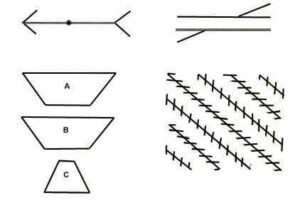
Brain and art
The diagrams above show that we do not see the individual parts but the whole; our overall view creates an optical illusion, our perception may be distorted but, above all, all our perception reinvents the world.
Perception is not an objective reproduction of the world
– If a picture represents an apple (we can define it as round, red, judge its size, etc.), cognition begins and the subject is identified. The apple refers to a notion of apple which exists for the observer. It can be connected to an affective process, for example by recalling a memory such as the smell of the pies the observer’s grandmother used to bake. The observer is active in front of the image.
The constancy of colour :
If we ask an observer what is the colour of coal in direct sunlight, the observer will see it as black. Similarly, a pile of snow at dusk will appear white. And yet a photoelectric cell shows that coal in sunlight is lighter than snow at dusk.
There is a constancy of colour in our brain and meaning belongs to the person looking at it : snow is invariably perceived as white.
The abstract image constructs us
In front of an abstract image, the observer’s symbolic process must construct the image differently. Indeed, the observer cannot rely on his or her experience in this case. Abstract artwork commands mental effort and this cerebral activity is part of our development.
Understanding becomes disconcerting because there are no references; it requires us to think harder.
Thus, the observer must make an effort to identify the image, to understand it.
Moreover, we see what we want to see or what we need to see.
Our motivation determines the field of hypothesis and as such modifies the field of our perception.
Perception is action, the perceptive act with which we structure the world. It is tied to what is acquired, which implies that it evolves and that there is no absolute nature.
cf.: The empiricist theories – Piaget / the child’s developmental stages – perception is learned.
Kilpatrick Experiments:
– A room is crooked, the walls are not straight.
Inside, a man touches the space, a degree of transfer occurs, he understands the space with his hands and as such finds his bearings; this implies that perception evolves.
– We put glasses which invert left and right on an individual. The brain then reinvents the correct direction. Innate, acquired, compulsive and affective perception can change with experience.
Art must be brought to everyone
We can distinguish acquired from innate in perception.
Abstract artwork does not impose a subject; it frees us from our references.
What is acquired becomes a determinant; in other words, looking at artwork will help mental elaboration. Hence the importance of making art accessible to a large audience: the presence of artwork improves our knowledge and the development of our capabilities. The more artwork we see, the more we are prepared to receive it and accept that there is no single, unique vision of the world.
Ten years of a model of aesthetic appreciation and aesthetic judgements: The aesthetic episode – Developments and challenges in empirical aesthetics
Helmut Leder and Marcos Nadal – Jully 2014





